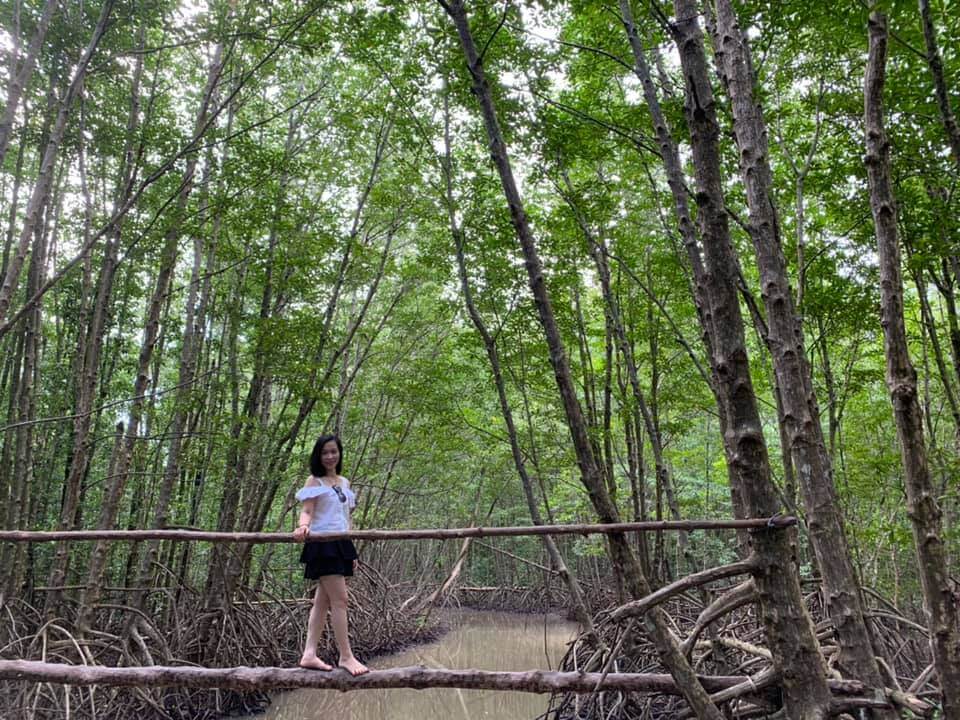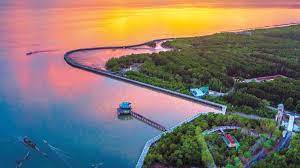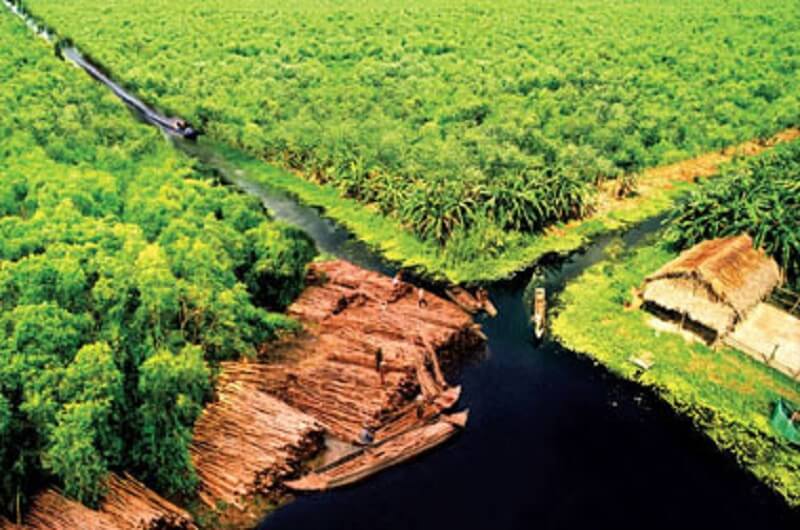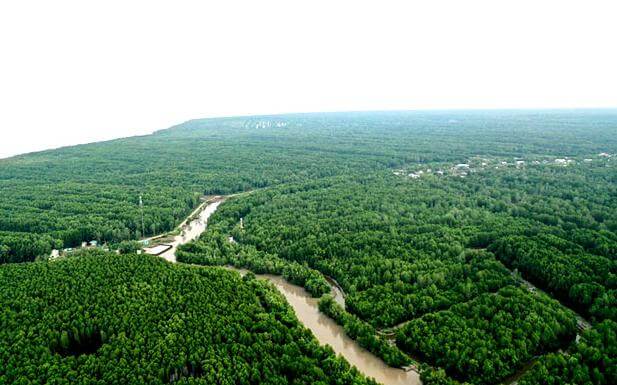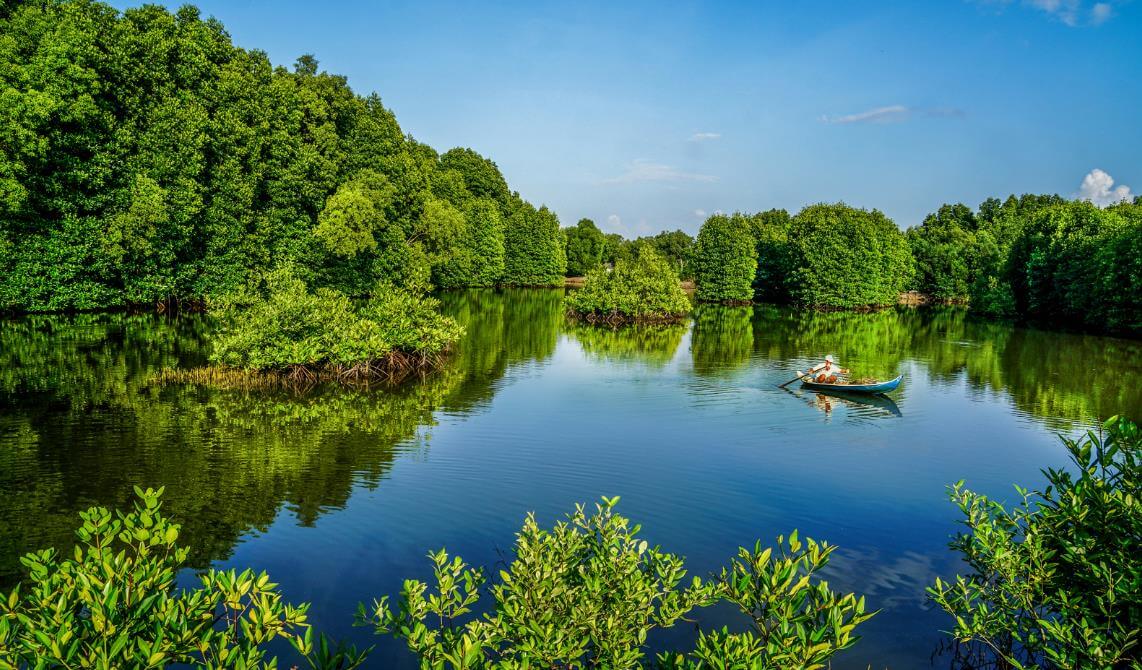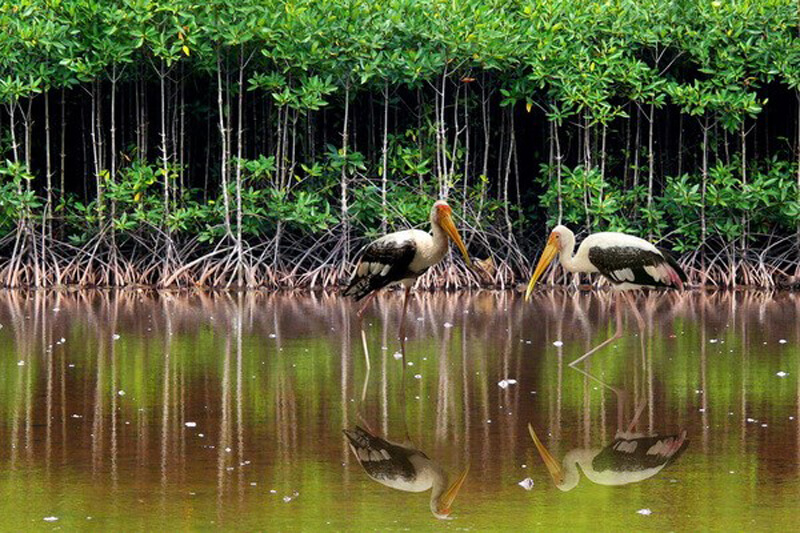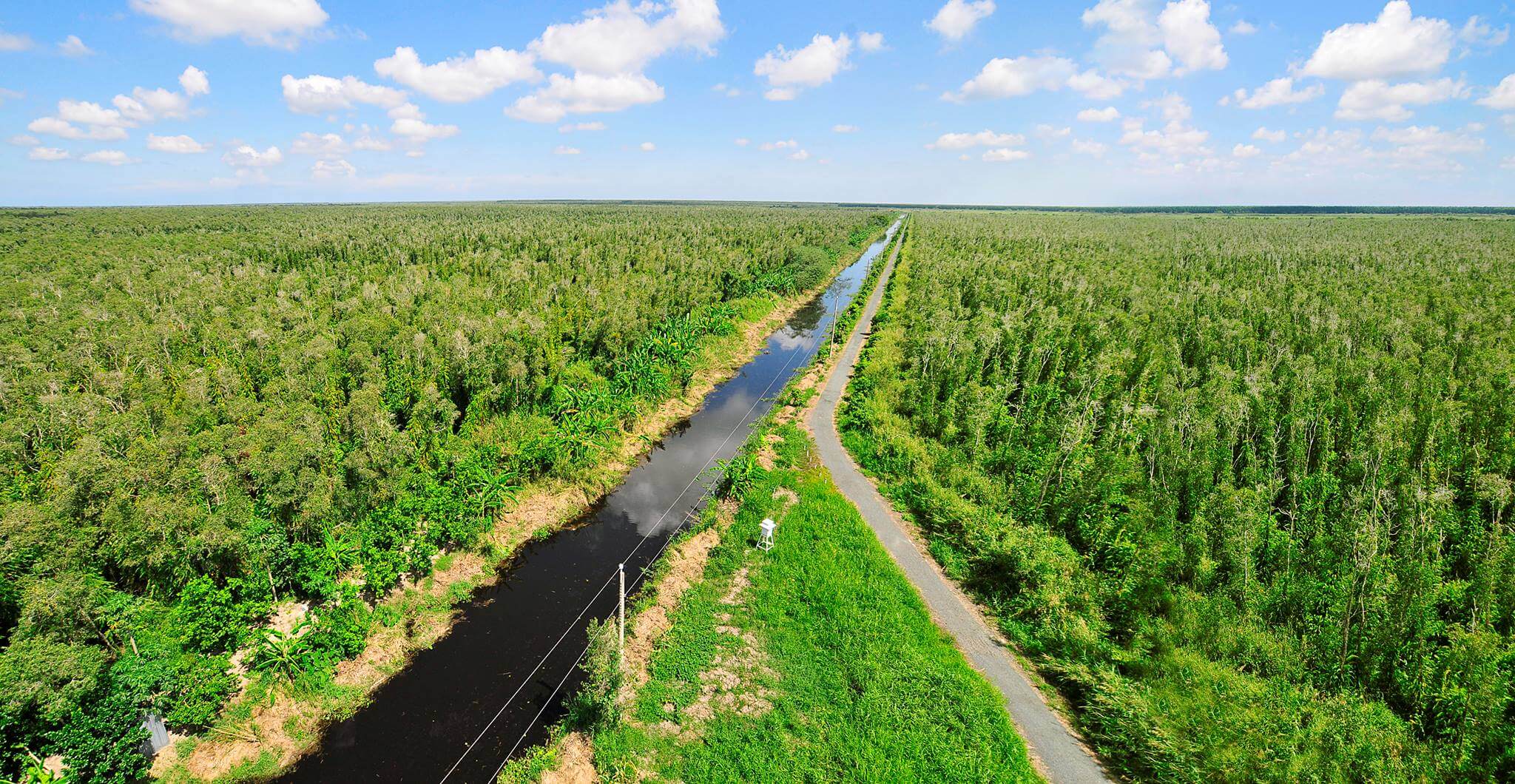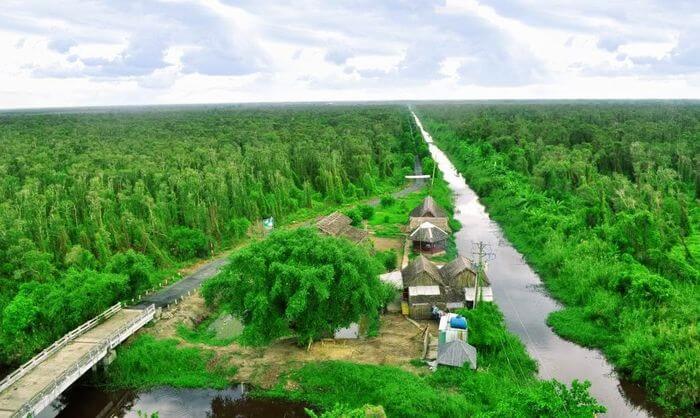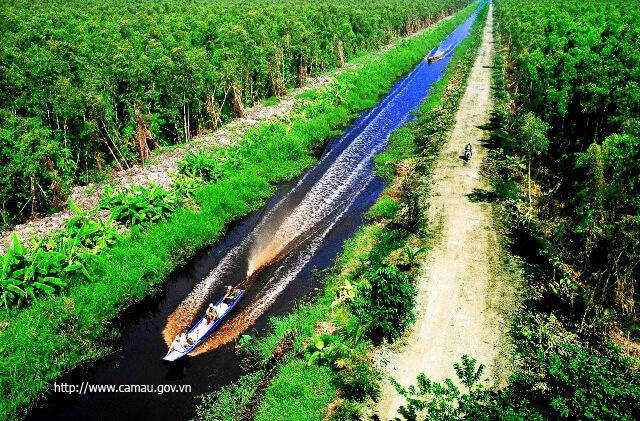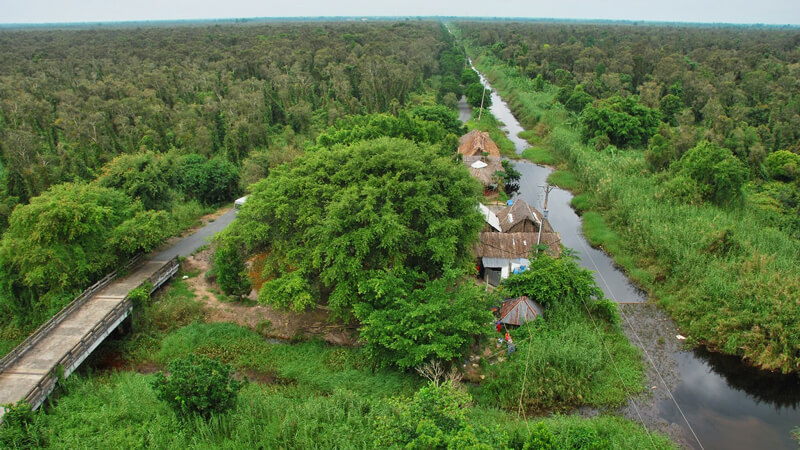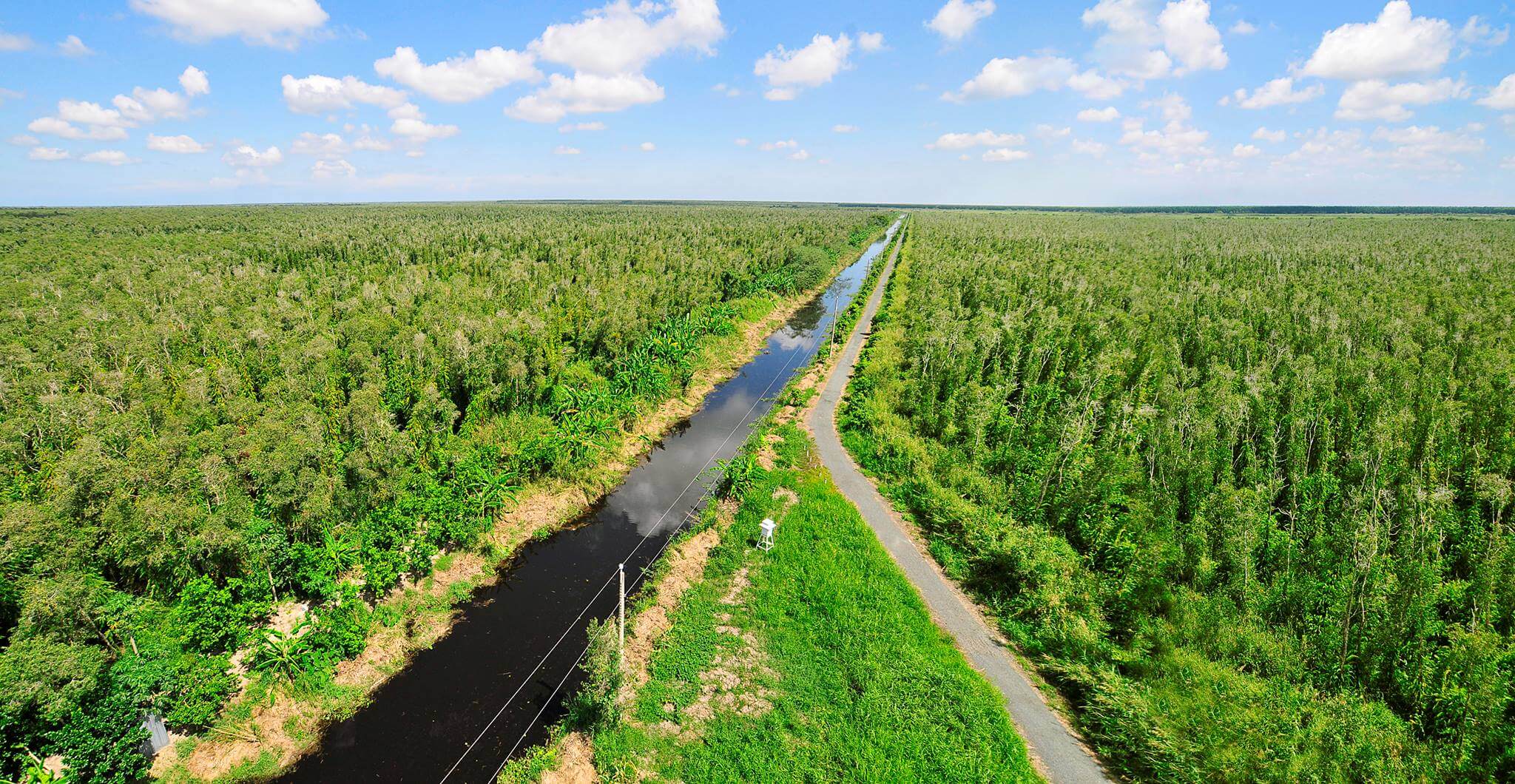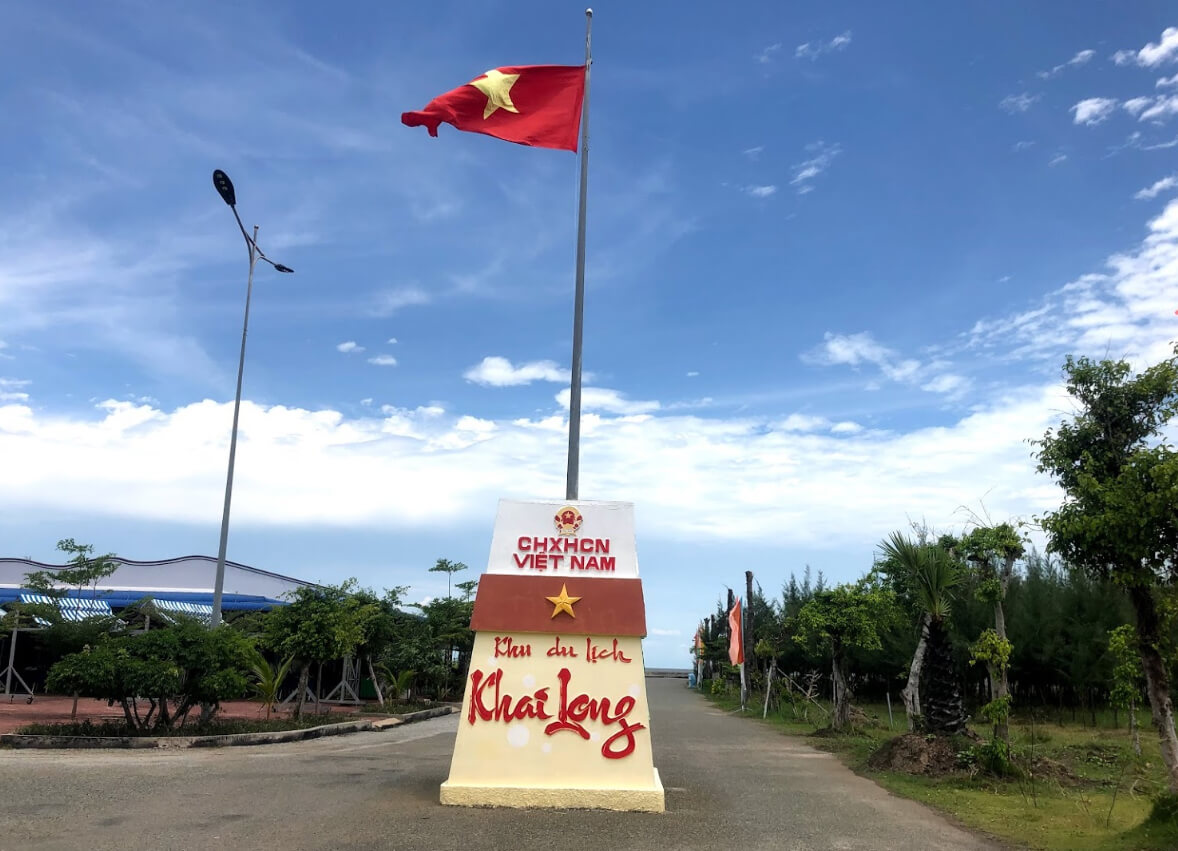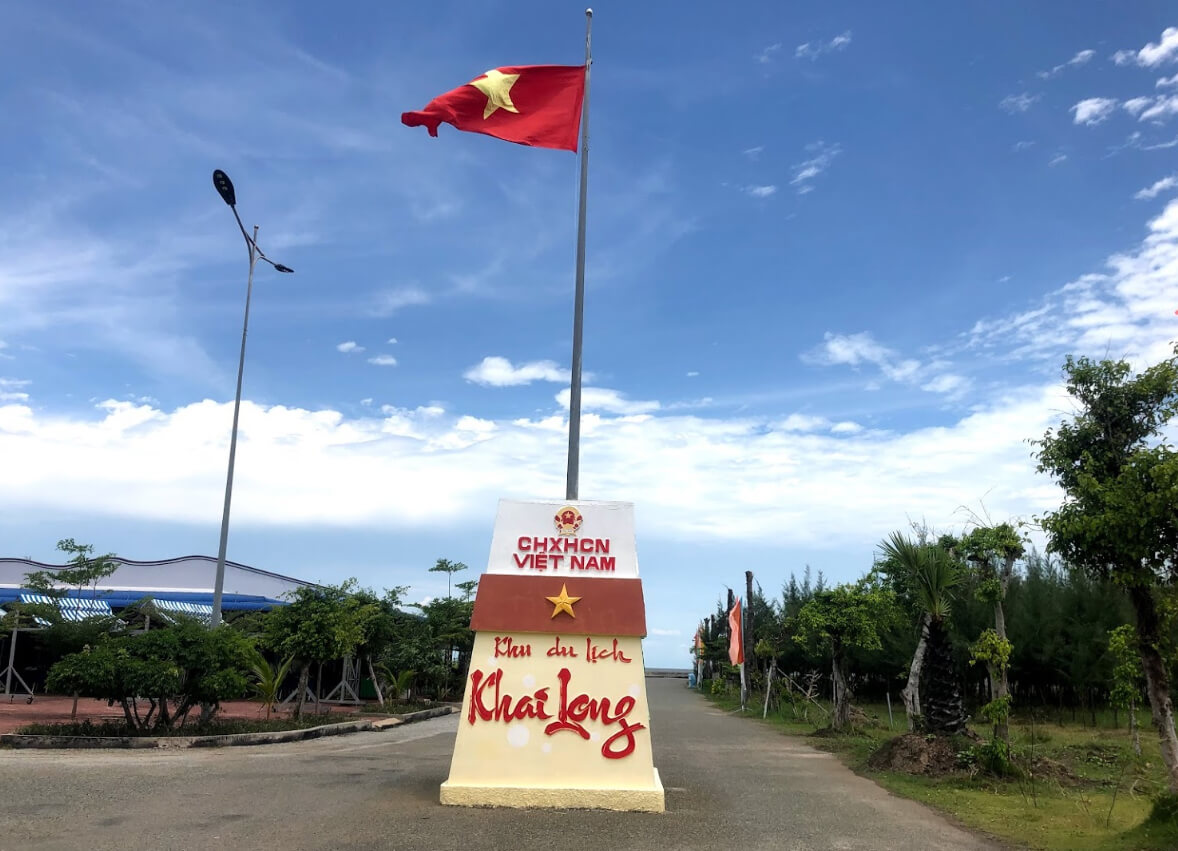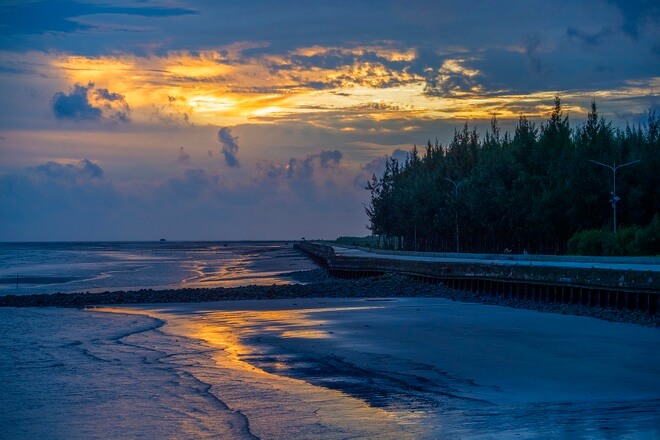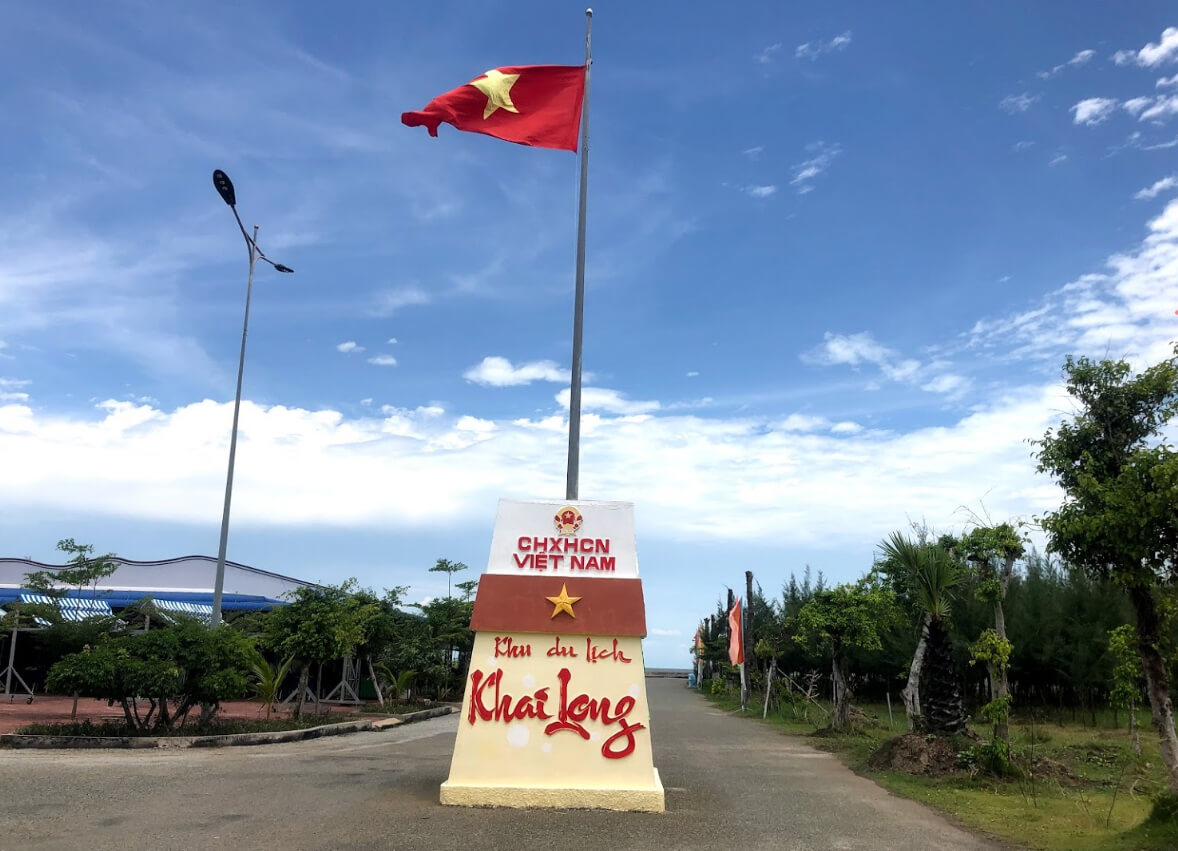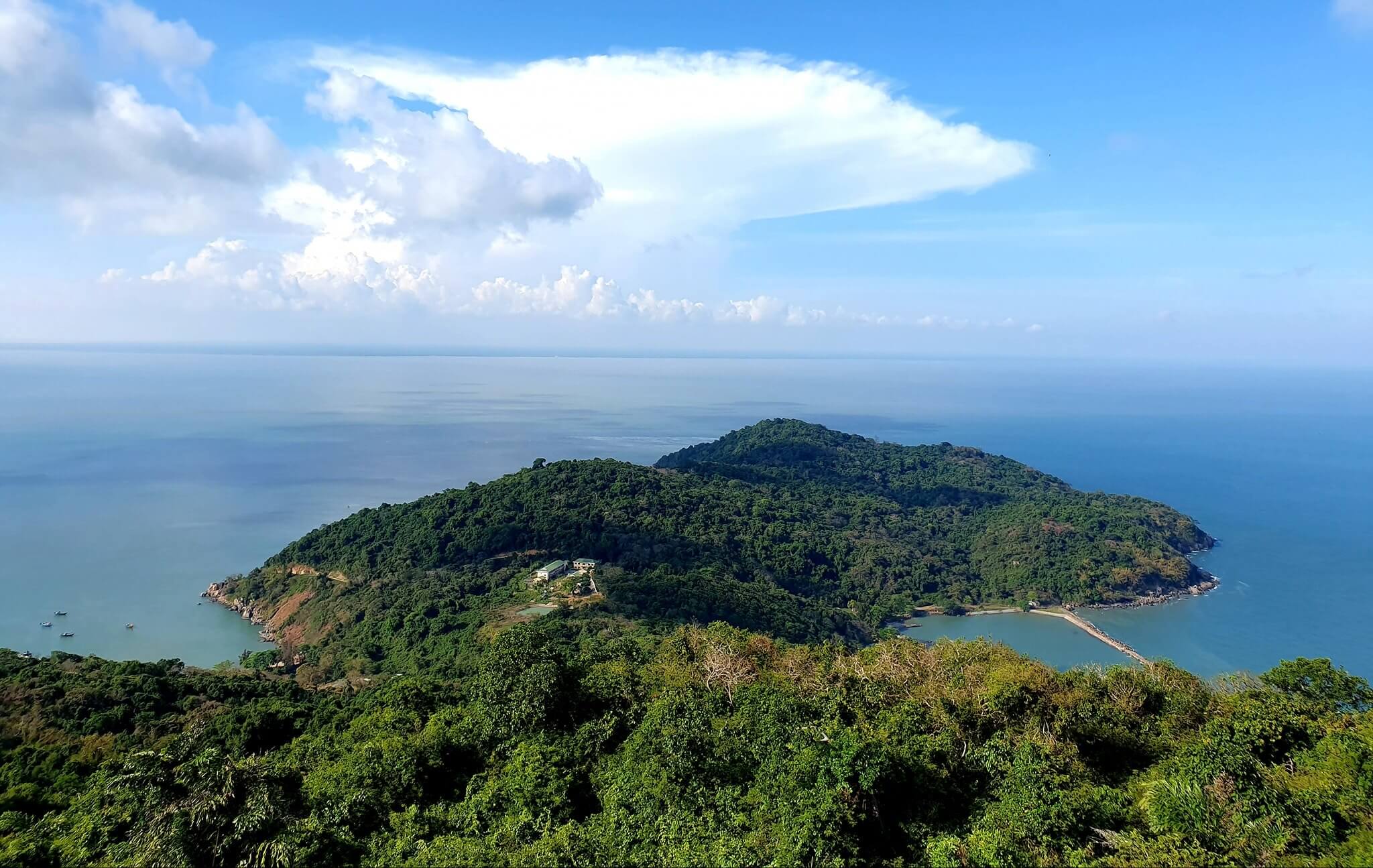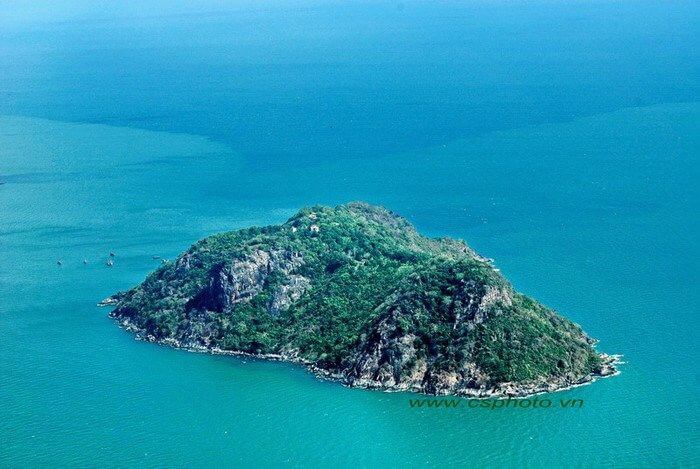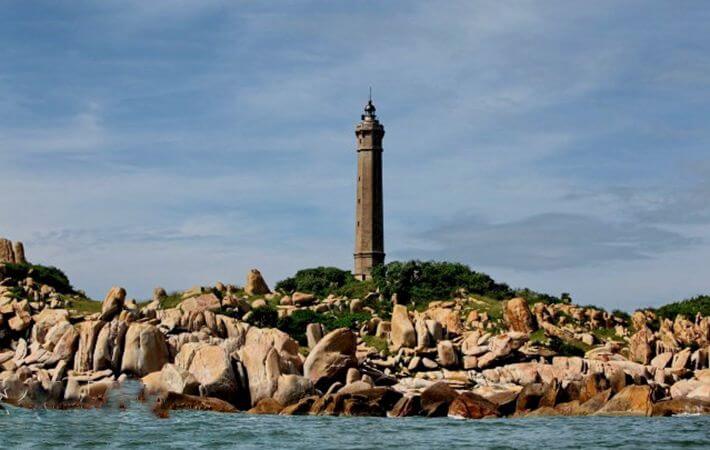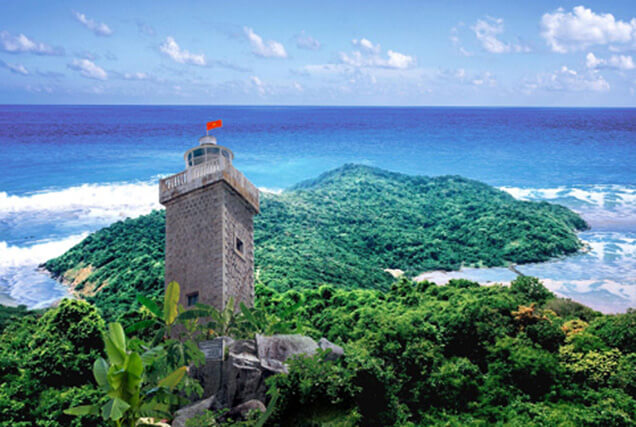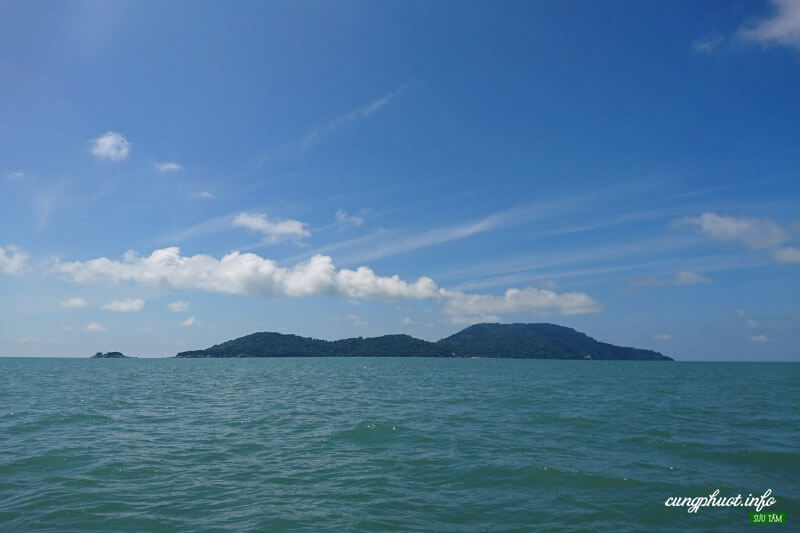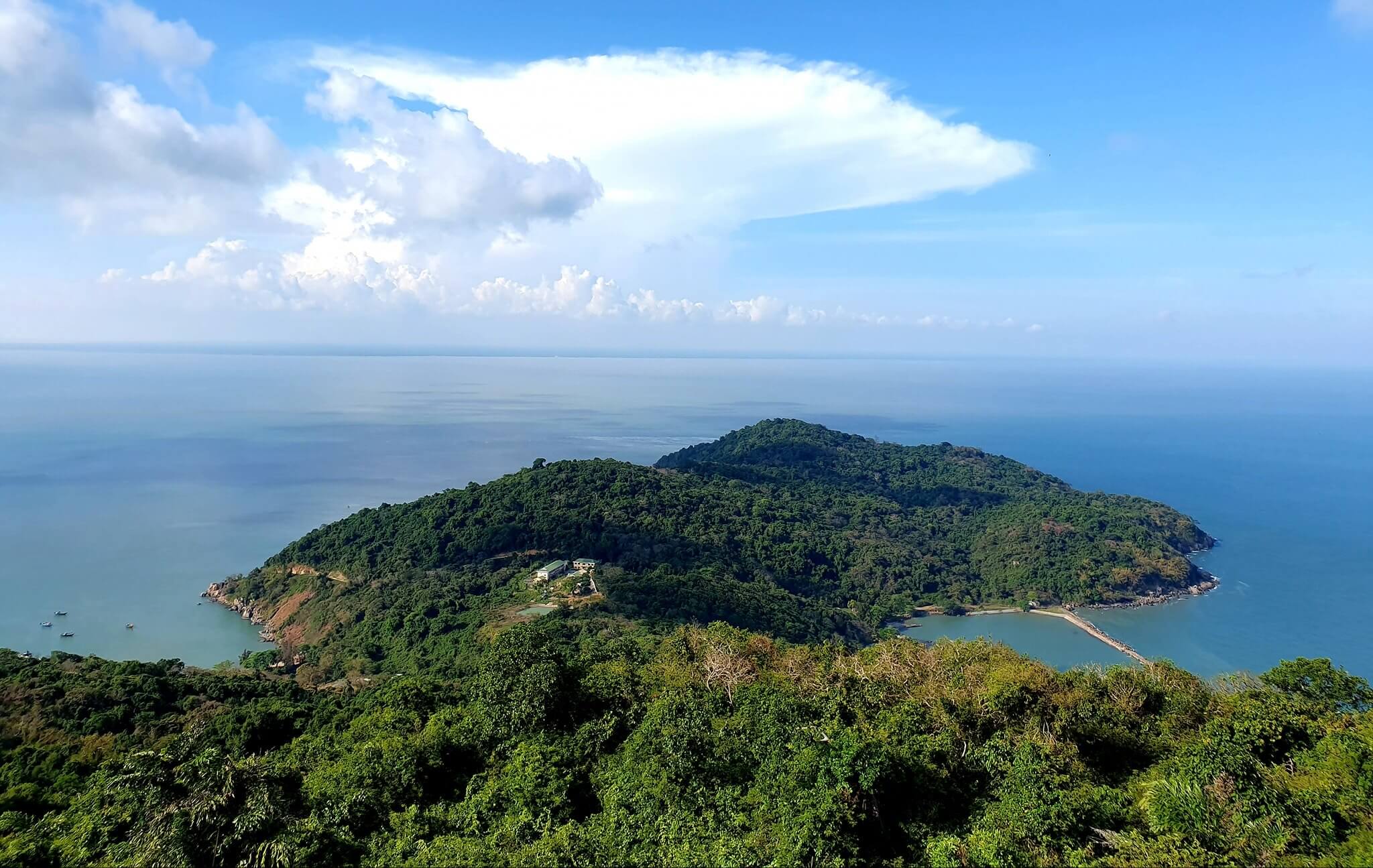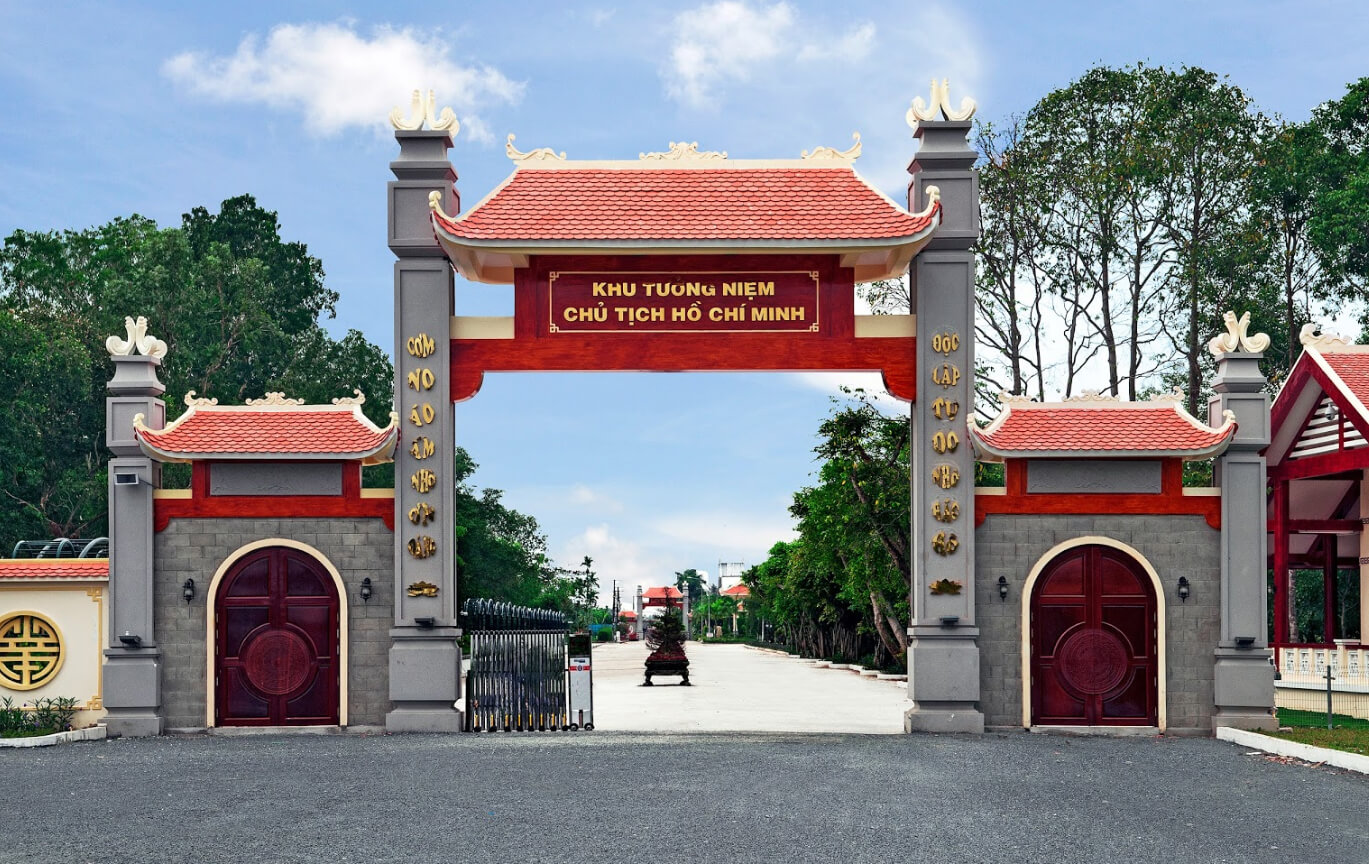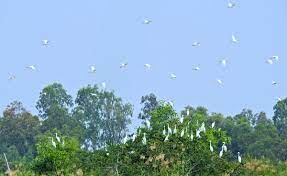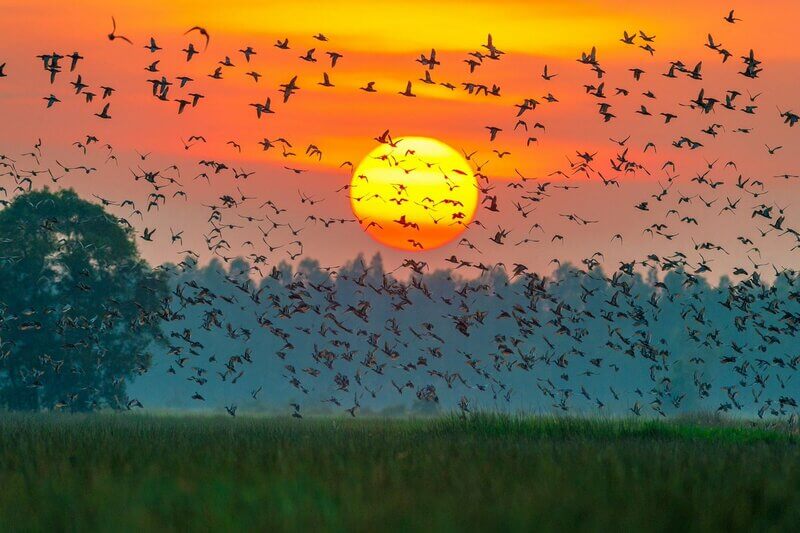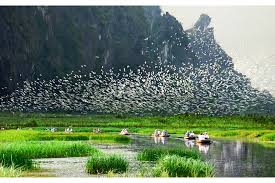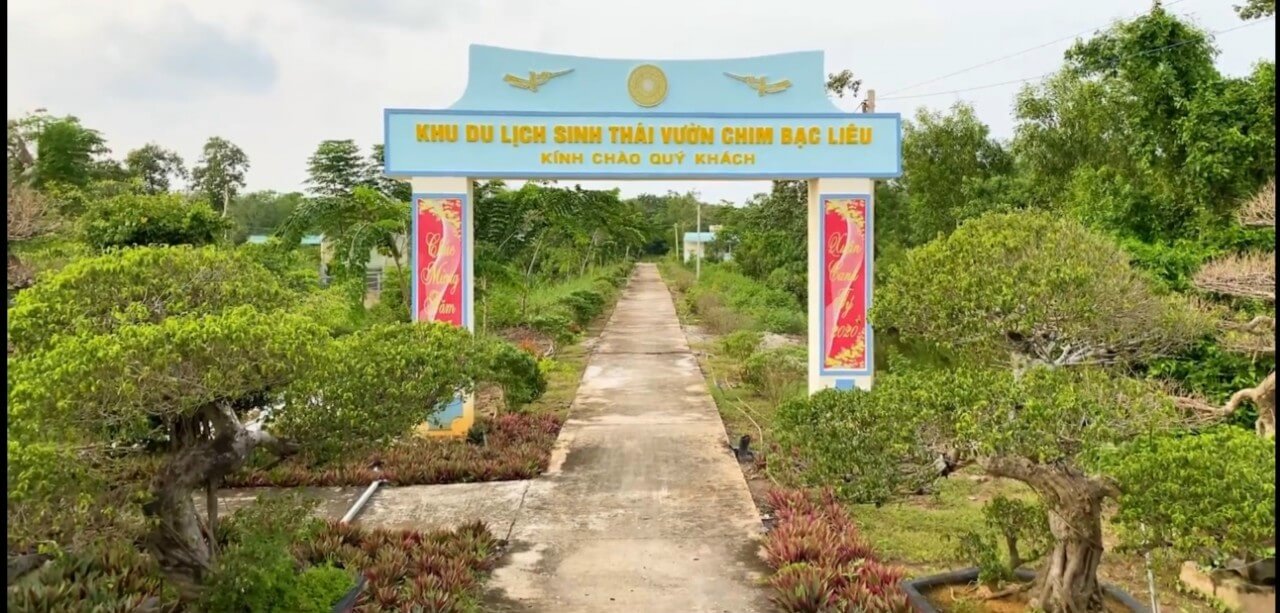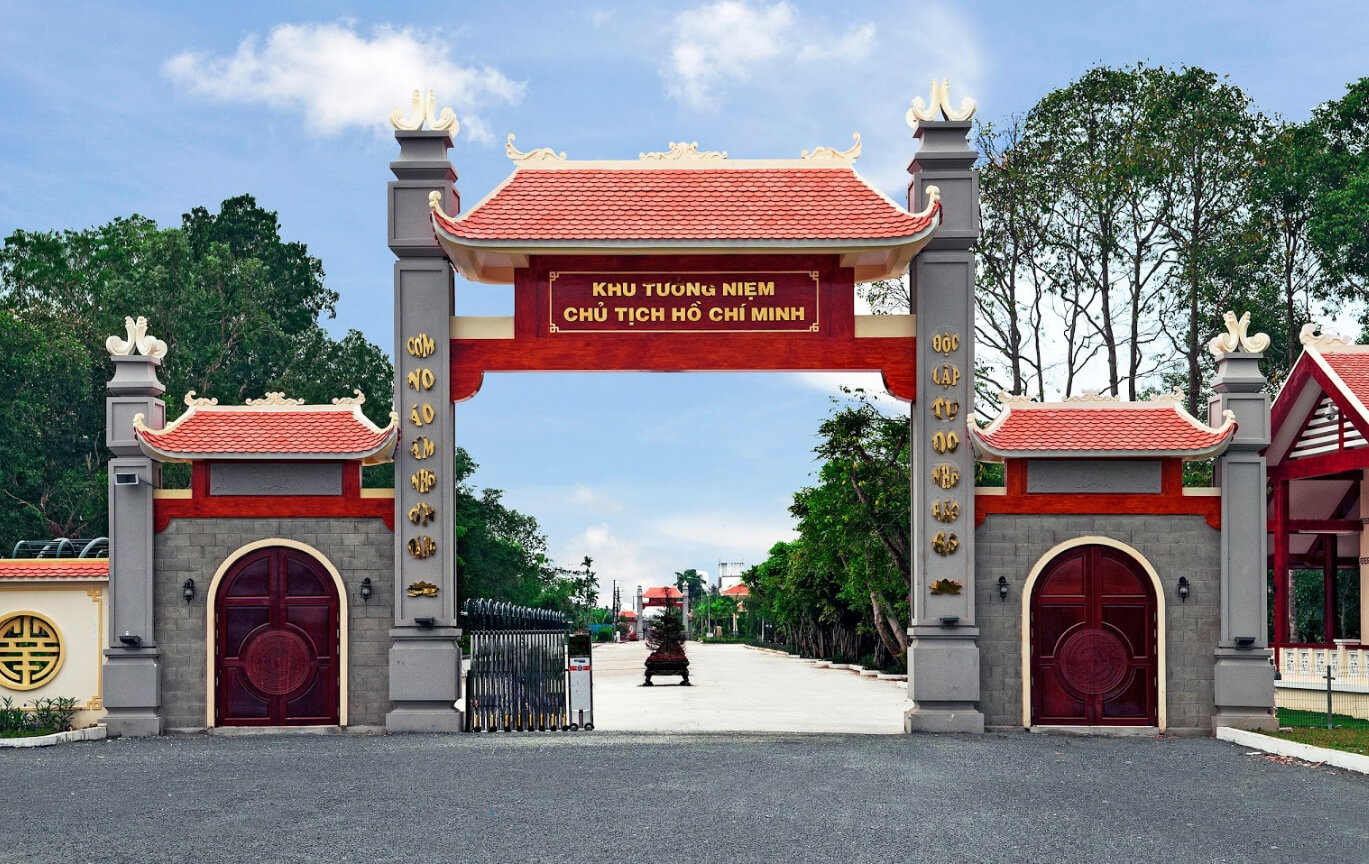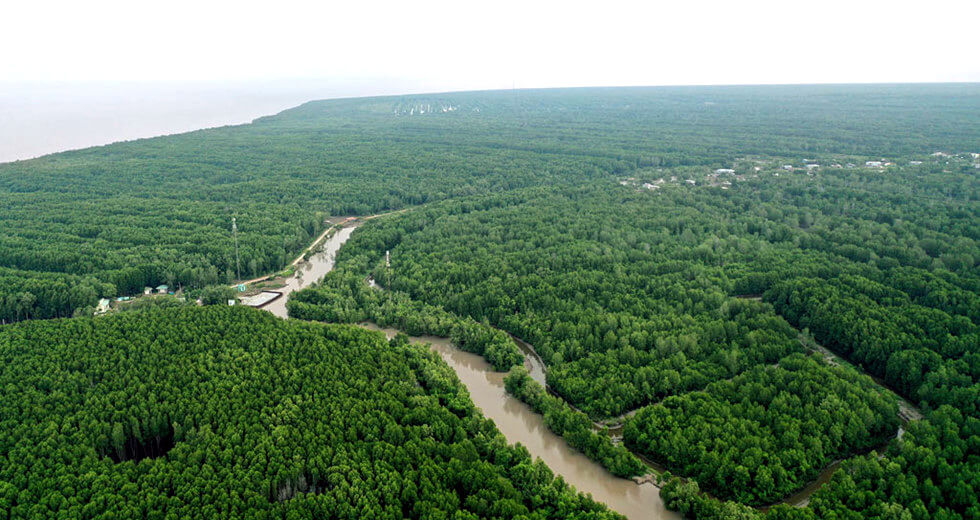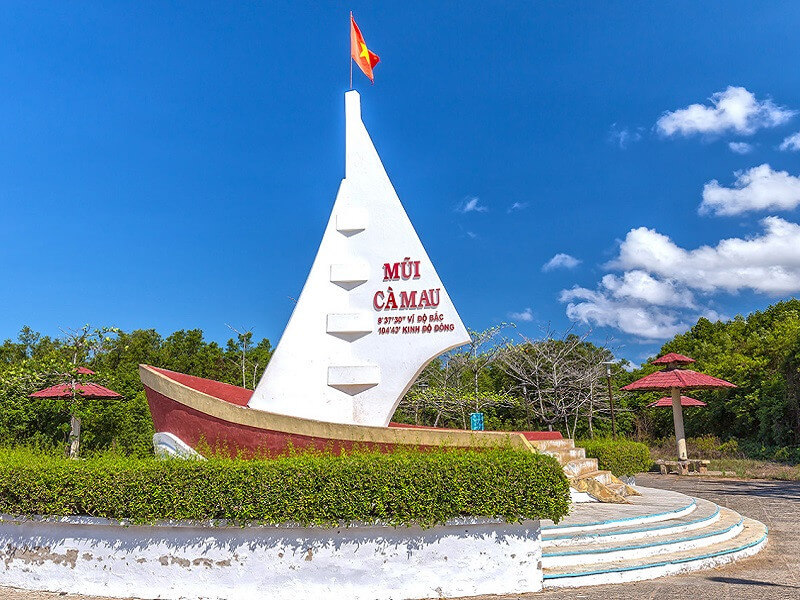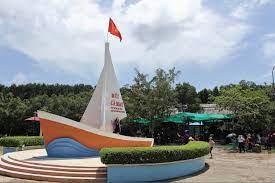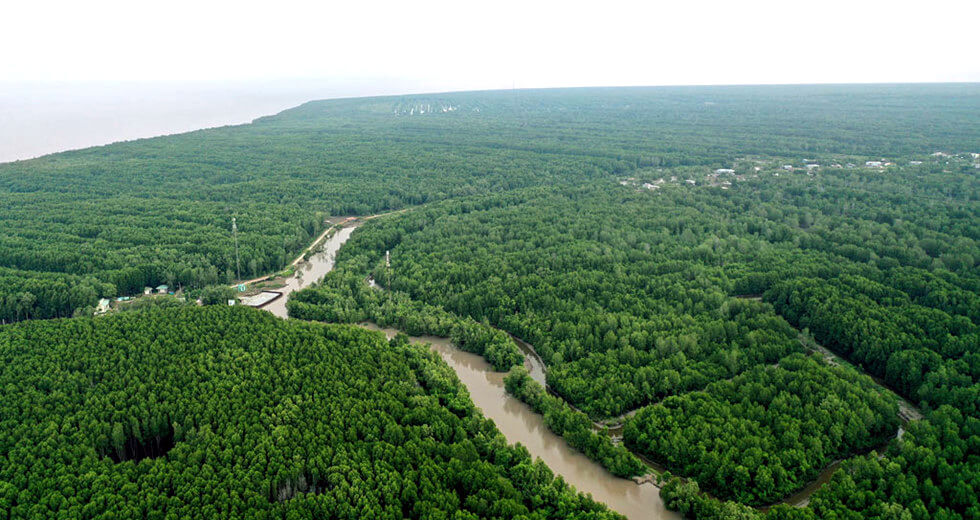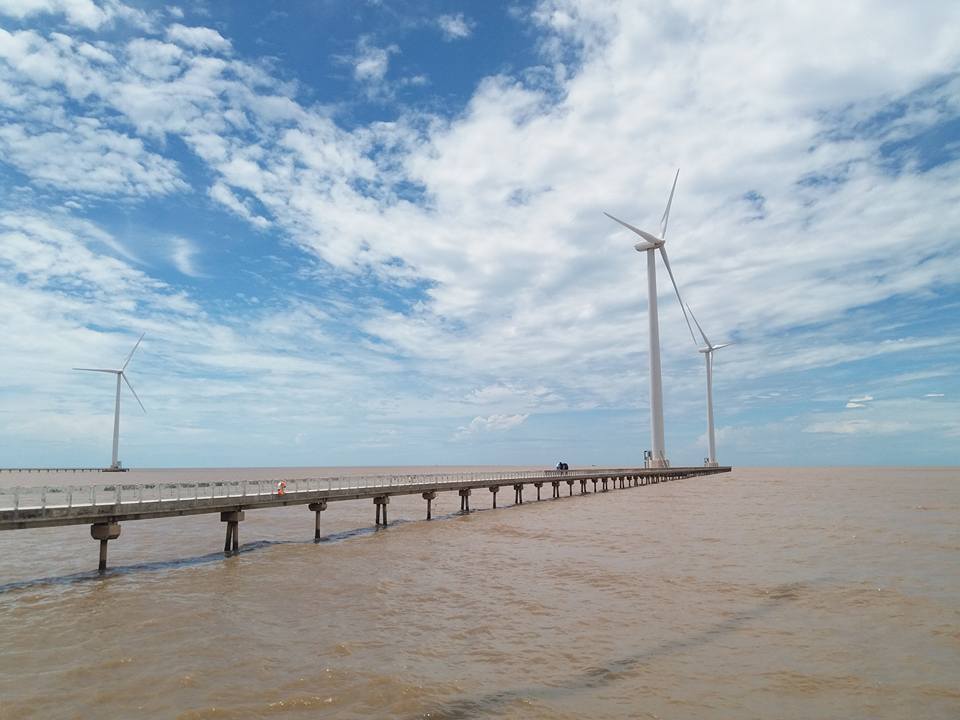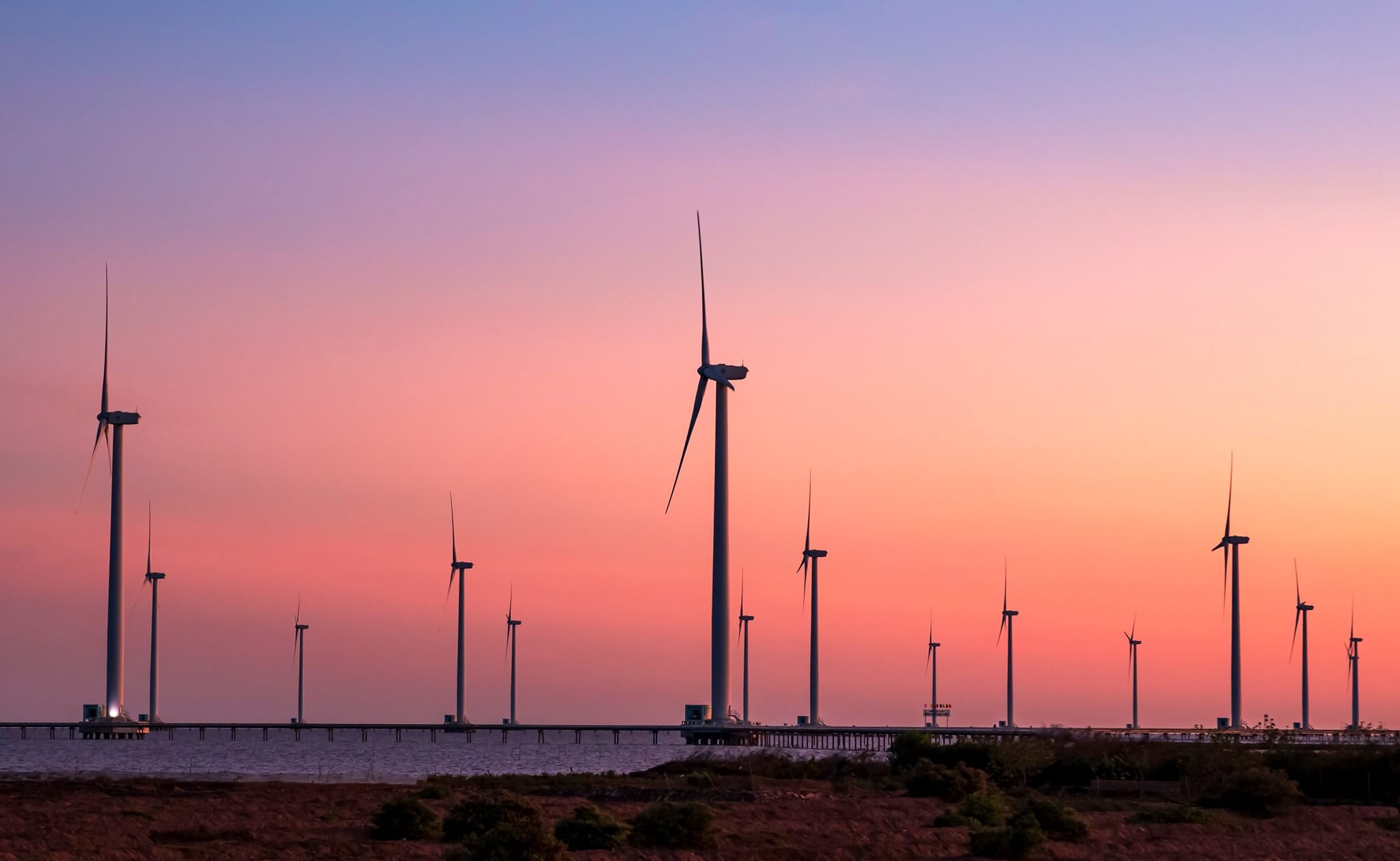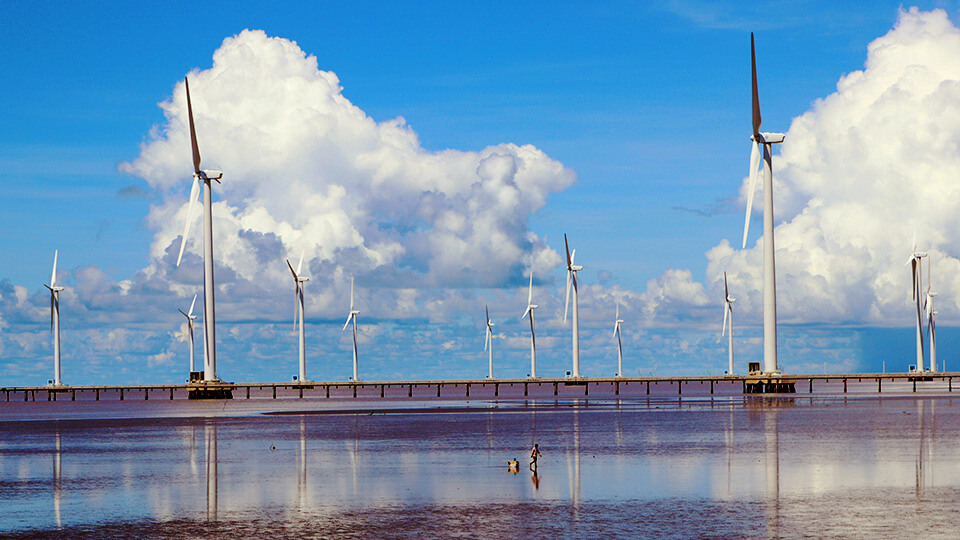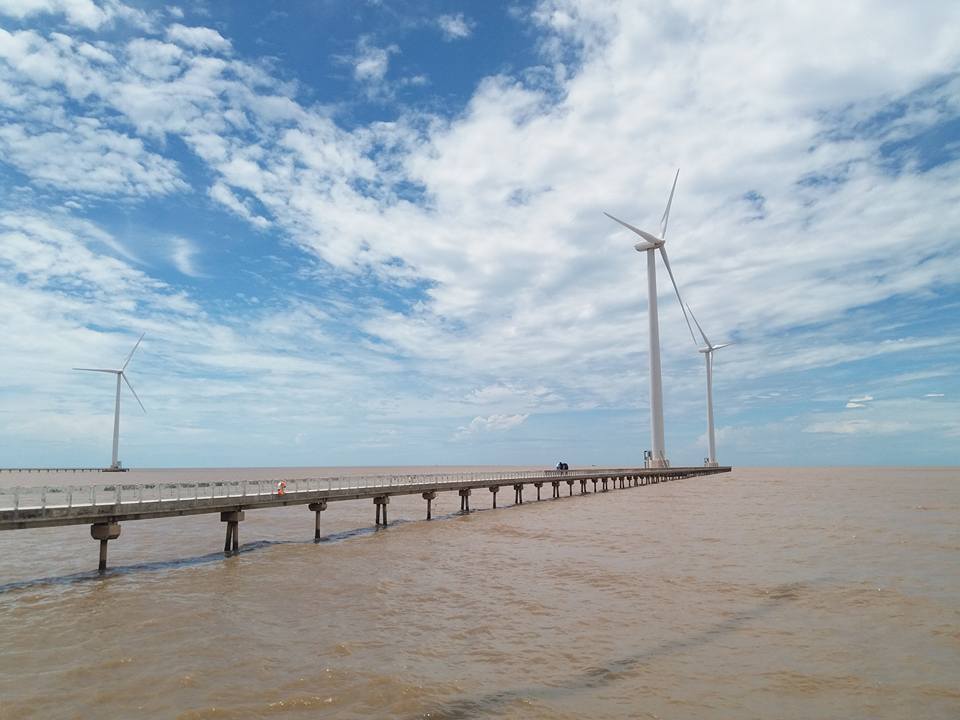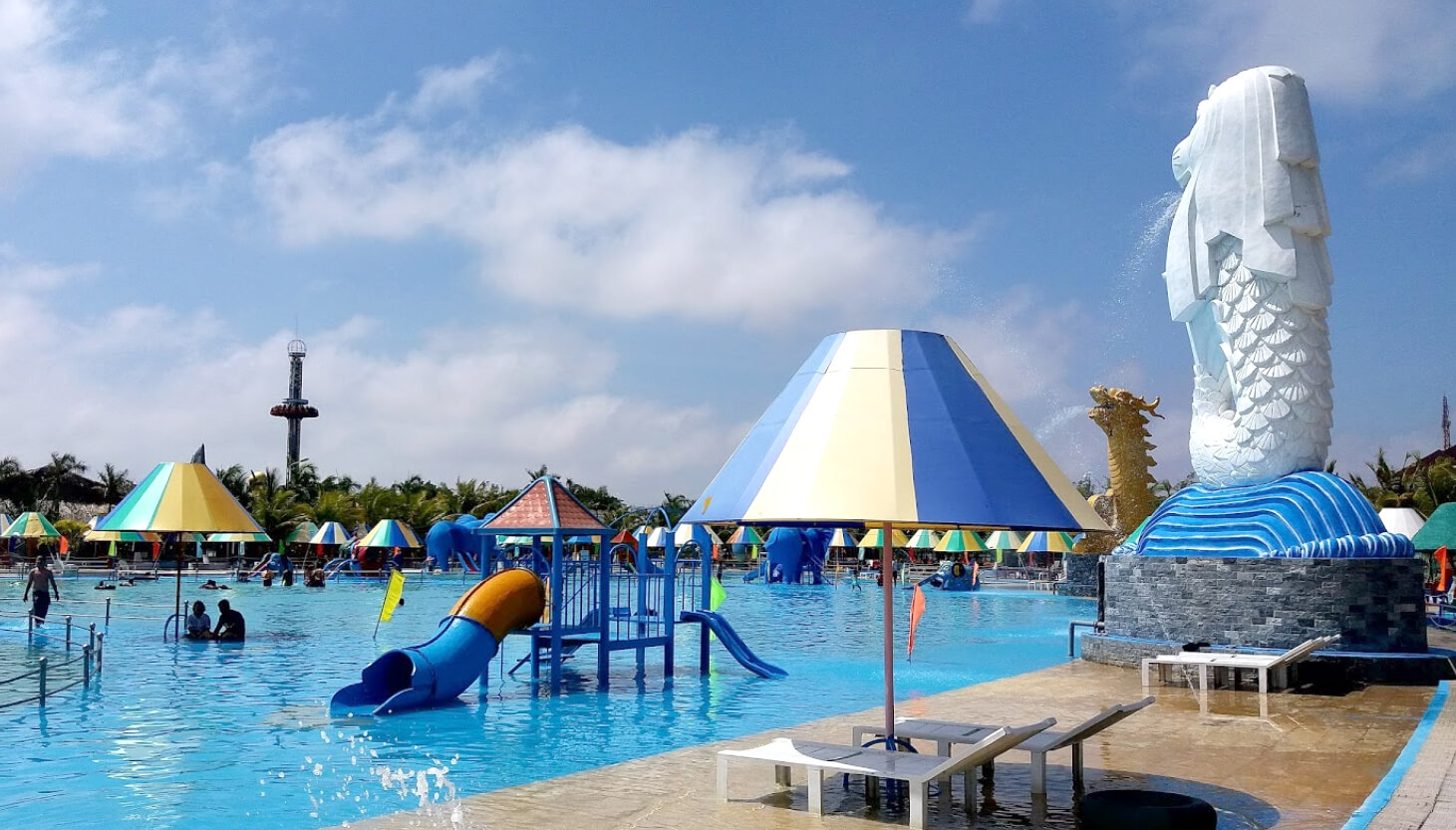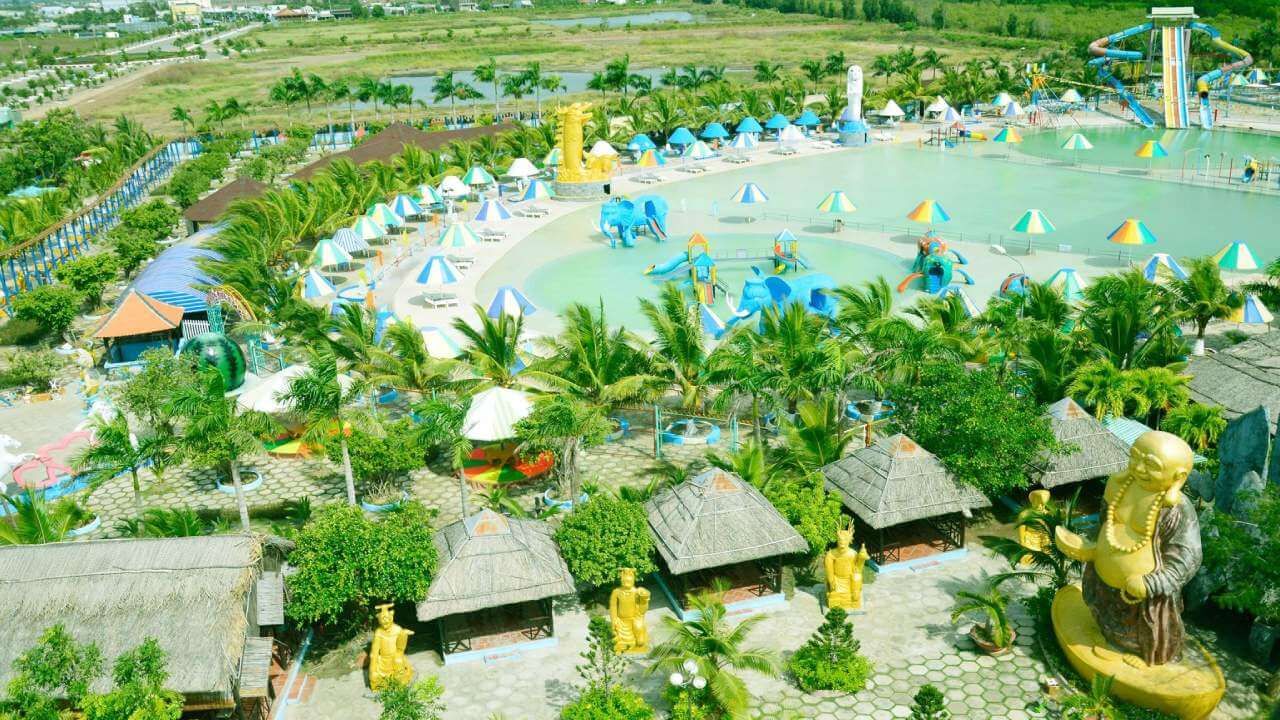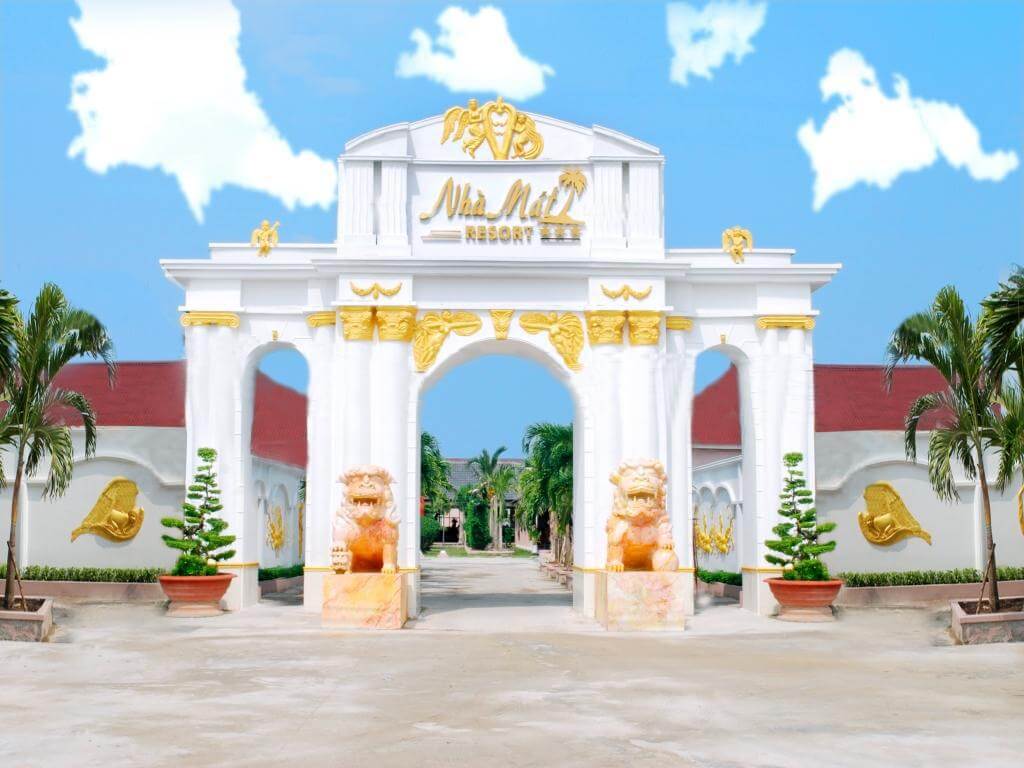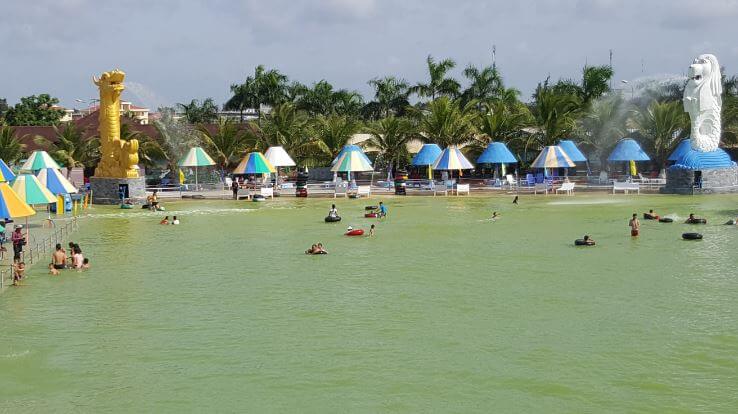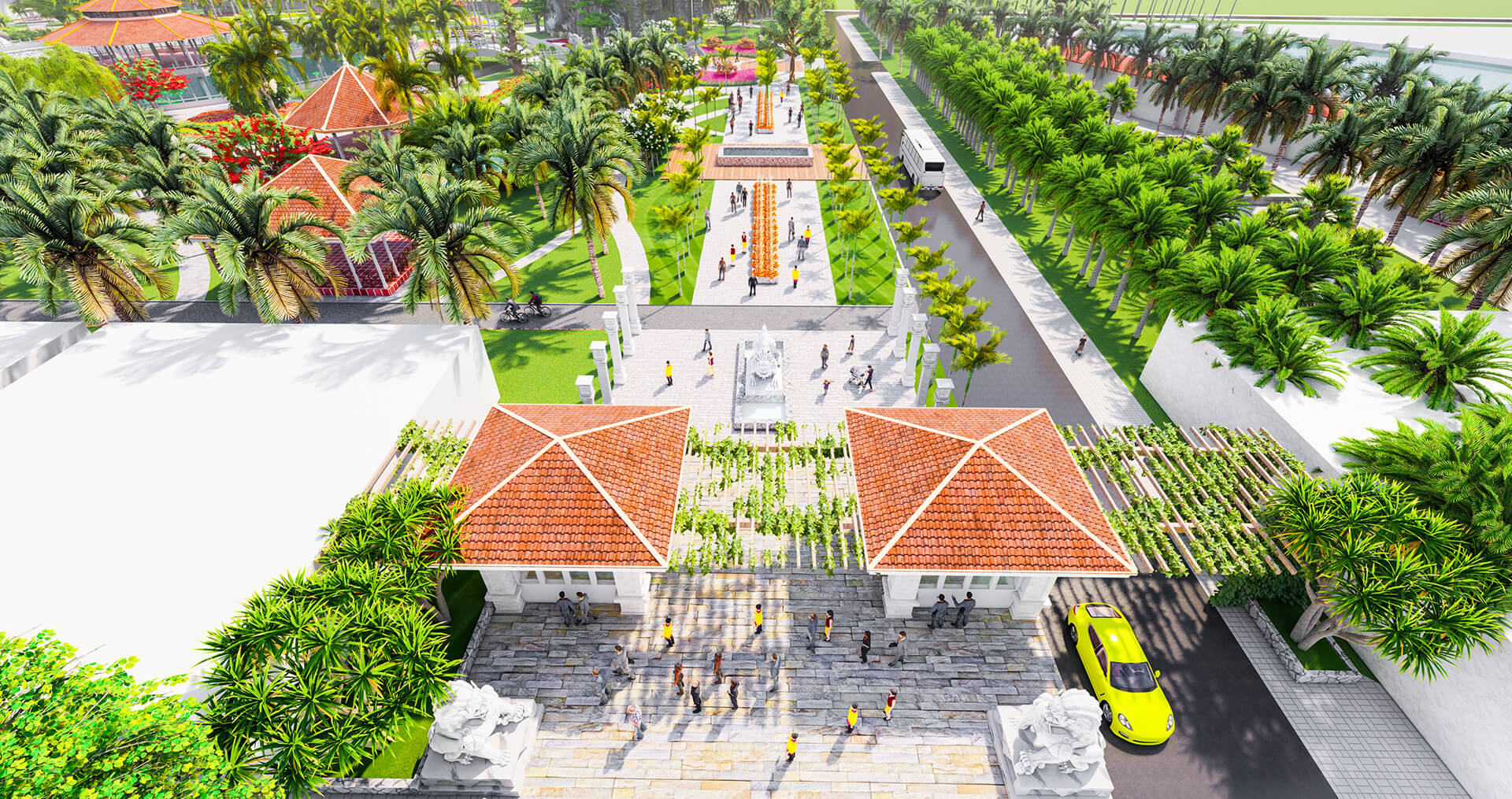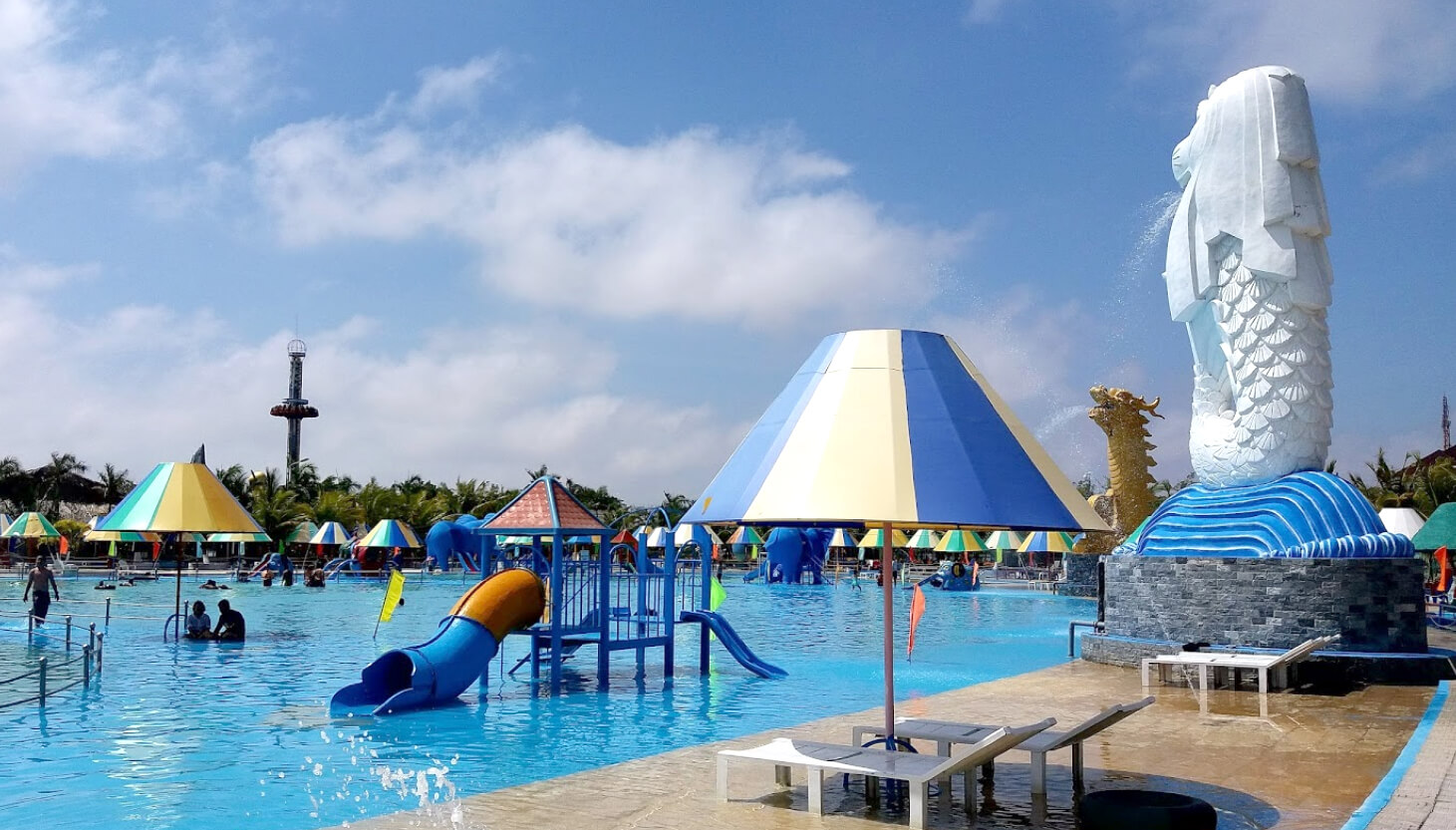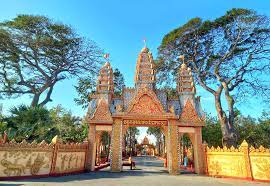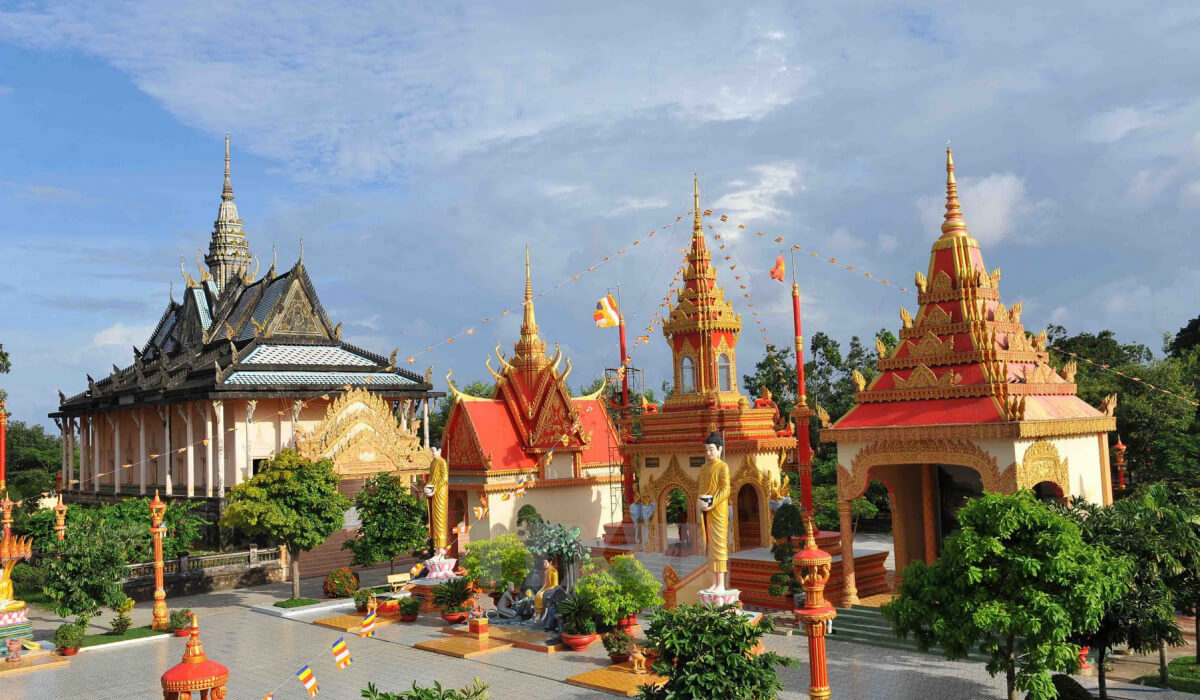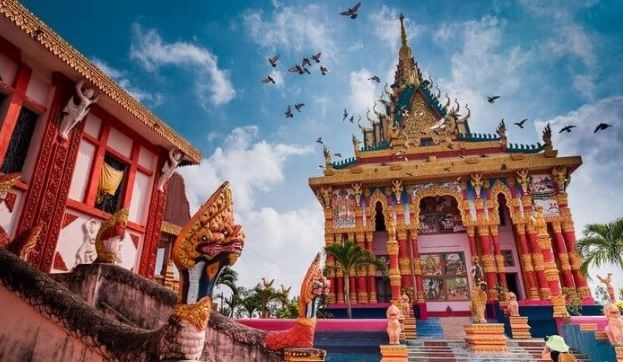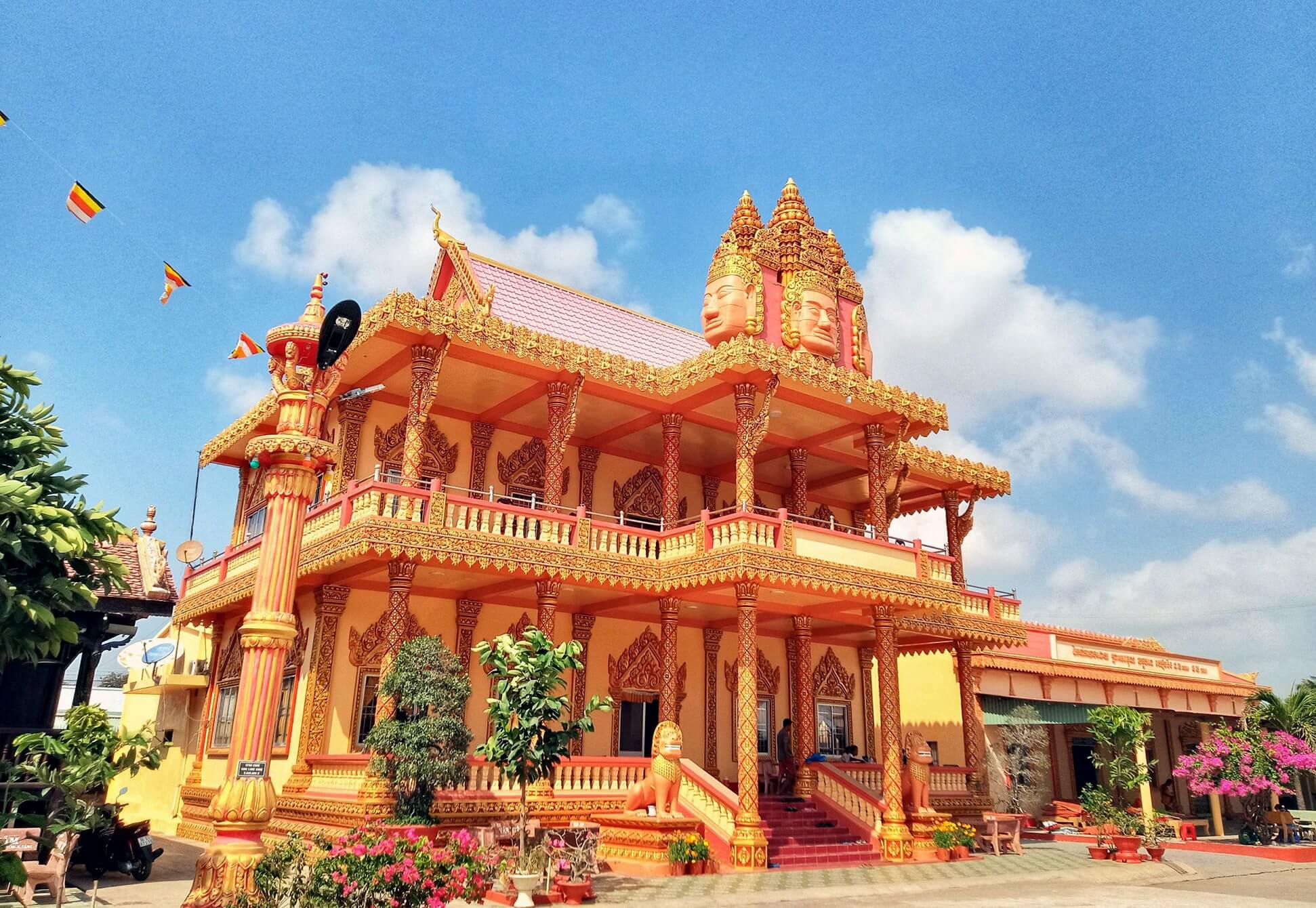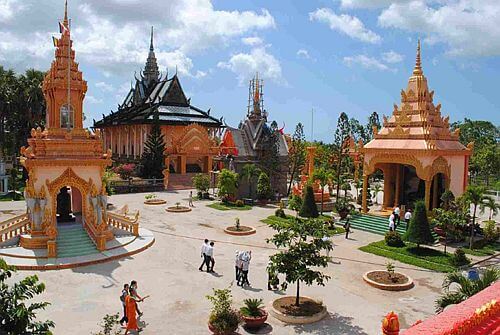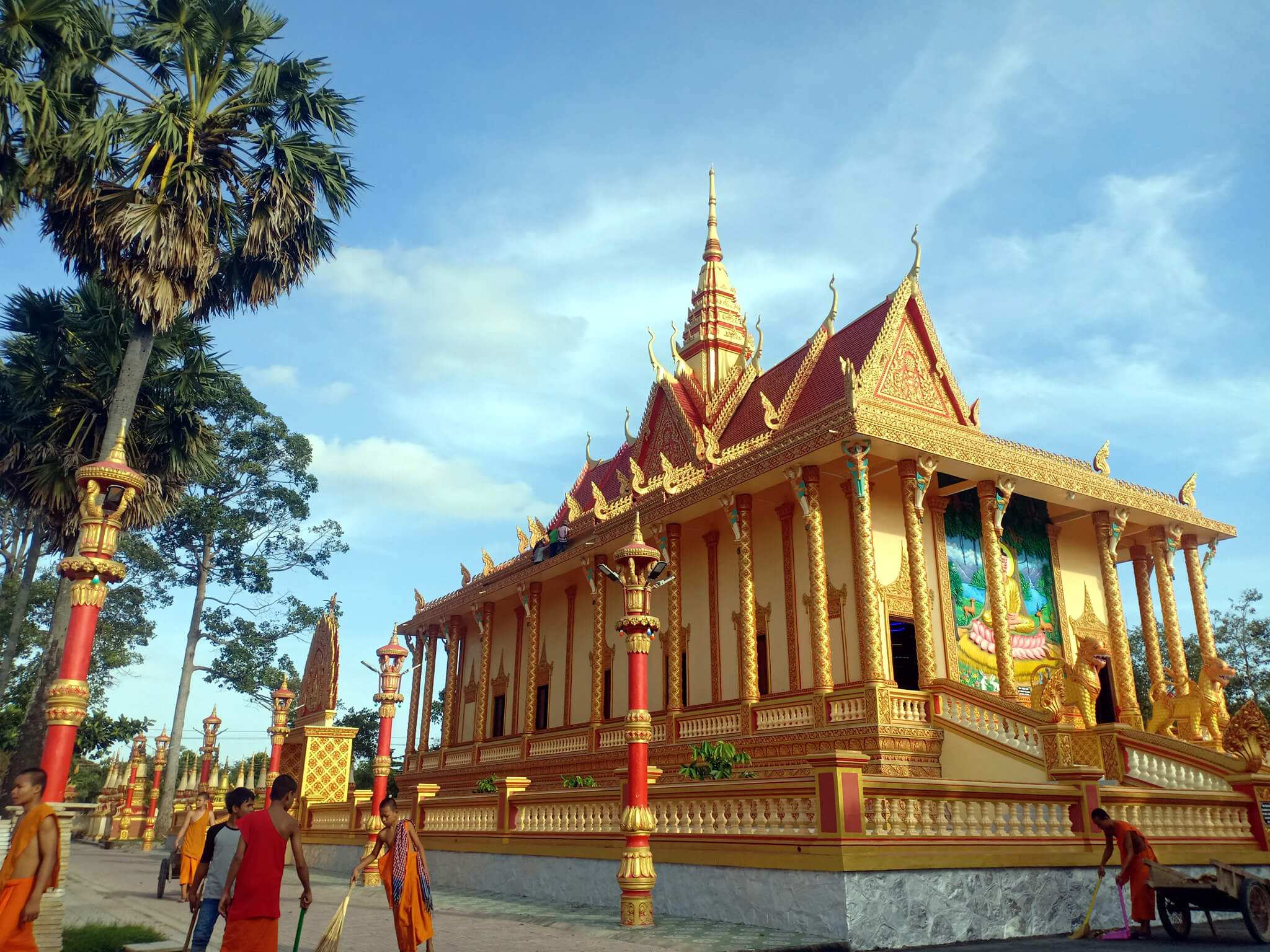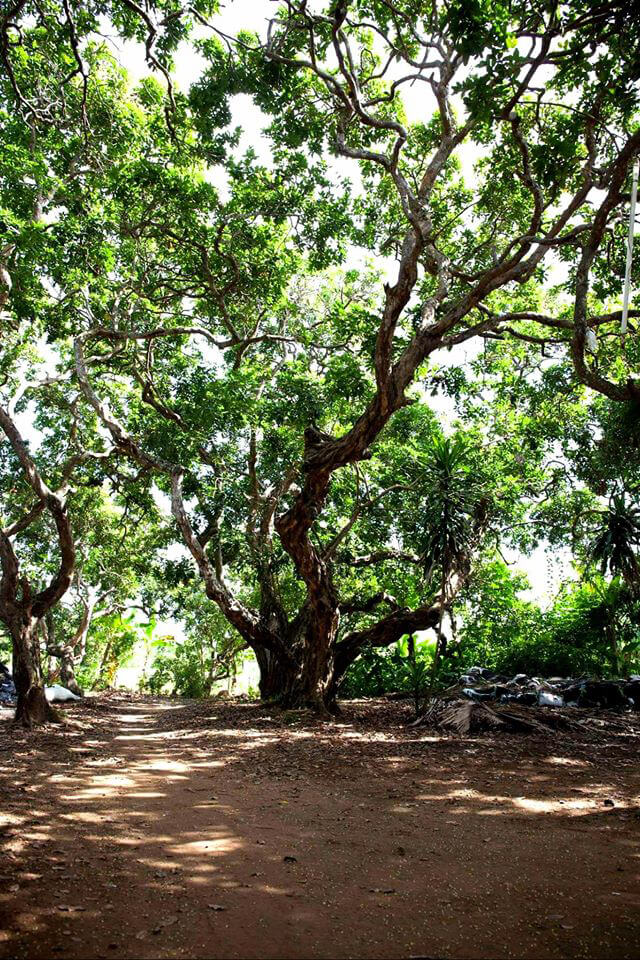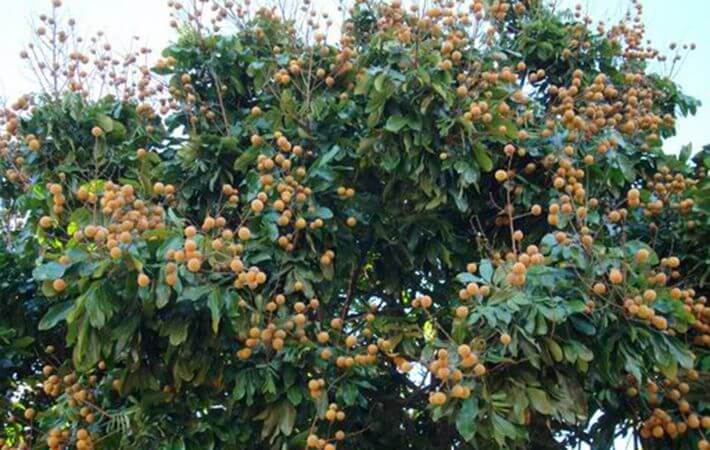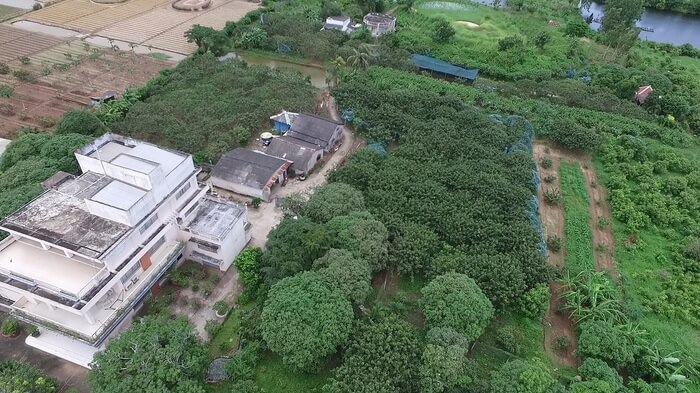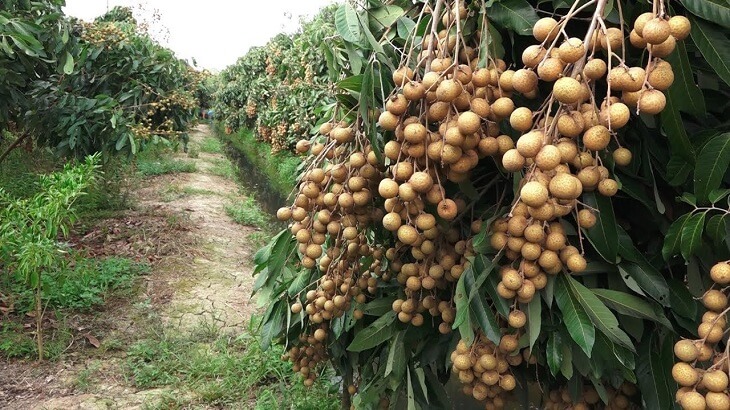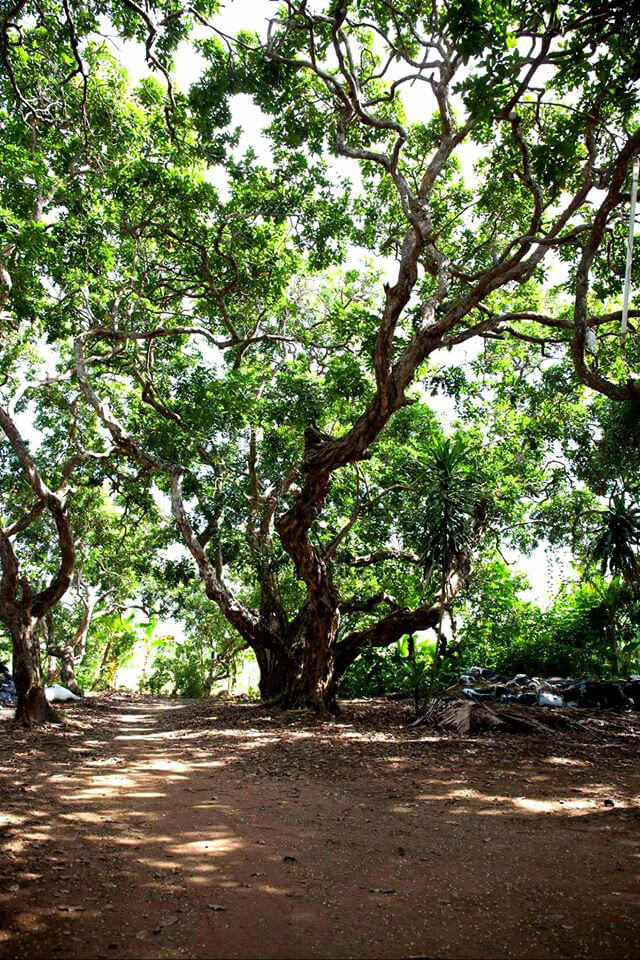Tourist destination
Na Hang tourist area
Ca Mau mangrove forest or Nam Can mangrove forest is a famous mangrove forest in the West. The forest has formed a solid protective membrane, preventing sea erosion, helping to control landslides and maintaining ecological balance. Coming here, tourists traveling to Ca Mau can not only visit, but can also participate in many other interesting outdoor activities such as boating, fishing and enjoying closeness to nature. During the resistance war against the French and the Americans, Nam Can mangrove forest became an important shelter for the revolutionary army. With its rugged river terrain, it played an important role in preventing enemy attacks and destroying small naval campaigns on the river. With the second largest area in the world, the mangrove forests here are second only to the Amazon forests of Latin America. The total area of the mangrove forest is 63,017 hectares, which is a habitat for many diverse species of creatures. When viewed from above, the forest looks like a V-shaped peninsula, with three sides facing the sea. Nam Can Ca Mau mangrove forest is a land with a quite pleasant climate. The best time to explore this land is during the dry season, from December to April. During this time, the air is dry and cool, creating favorable conditions for sightseeing and experiencing. However, from May to November, the long rainy season can hinder tourism activities. In particular, if visitors plan to tour Ca Mau in July or August, they will have the opportunity to enjoy many more delicious and attractive specialties. To visit Nam Can mangrove forest, visitors must travel by tourist boats, along both sides are rows of mangrove trees. Floating on the boat, the deeper you go, you will clearly feel the fresh and cool air. While walking, I heard local people tell stories about the origin of this forest. It's very interesting, isn't it? Going deeper inside, visitors will see wild, majestic natural scenes, the gradual appearance of an almost unexplored core of primeval forest. There are ancient trees with huge trunks that 5 to 6 people cannot hug... This place is extremely worthy of being chosen as the most attractive tourist destination in Ca Mau. Not only that, visitors also have the opportunity to see thousands of flocks of birds converging on the branches of mangrove trees, creating an extremely beautiful and interesting scene. Just by raising the camera, visitors will see countless wonderful photos with interesting scenery appearing before their eyes.
Ca Mau
From May to November
5439 view
U Minh Ha Forest
U Minh Ha National Park is an ideal destination for those who love the natural and wild beauty of Dat Mui Ca Mau river. As a large-scale biosphere reserve, U Minh Ha is famous for its green vegetation, diverse ecosystems and unique natural scenery. U Minh Ha National Park is located in the west of Ca Mau province, within the administrative boundaries of 4 communes in 2 districts of U Minh and Tran Van Thoi. U Minh Ha is about 40 km from Ca Mau city center and can be reached by car. The total area of the forest is up to 8,527 hectares, one of the three core areas of the Ca Mau Cape World Biosphere Reserve. This place is famous for its Melaleuca forest ecosystem formed in alum, flooded conditions, and on peat soil. The ecosystem is diverse and rich with more than 250 species of plants, 40 species of mammals, 182 species of birds, 20 species of reptiles, amphibians and many other insect species. Among them, there are many rare species listed in the Red Book of the International Organization for Conservation of Nature. The weather in U Minh Ha is divided into two distinct seasons: dry season and rainy season. The dry season starts in May and ends in October, the rainy season lasts from November to April of the following year. According to U Minh Ha travel experience, visitors can visit and explore this National Park at any time of the year. The rainy season is when the water level is high, making it easier to travel by boat around the mangrove forests. On the contrary, the dry season will be more favorable for sightseeing because it is sunny and there is no rain. If you want to come here to explore the ecosystem or take check-in photos, the dry season will be a more ideal time. From City. Ho Chi Minh, there are 2 ways to get to U Minh Ha National Park. If traveling by motorbike, from City. Ho Chi Minh City, you can follow National Highway 1A, cross Ca Mau bridge to Ngo Quyen and Vo Van Kiet streets, follow the signs to reach U Minh Ha forest. On the way, you should ask local people to avoid getting lost. If traveling by bus, City Line. Ho Chi Minh - Ca Mau has passenger buses departing from Eastern, Western or An Suong bus stations. Bus ticket prices usually range from 180,000 - 200,000 VND/ticket. Reputable bus companies that you can refer to are: Phuong Trang, Lien Hung, Ngoc Ha, Mai Linh, Giap Diep... From Ca Mau bus station, take a taxi or motorbike taxi to get to U Minh Ha. Most tourists coming to U Minh Ha National Park go back and forth during the day, not staying overnight. Accommodation services around the forest are not yet developed, so you can stay at motels and hotels in Ca Mau city. U Minh Ha travel experience also shows that staying in the city center will be more convenient for moving and exploring other tourist destinations. When visiting U Minh Ha forest, you can participate in activities such as: Admiring the scenery of U Minh Ha forest from the observatory, Visiting the mangrove forest by boat, Fishing and collecting honey in the forest,... In addition, you need to note the following points when traveling to U Minh Ha Forest. First, bring a hat and umbrella to protect yourself from the sun, and choose comfortable clothes for ease of movement. Second, if you come here during the rainy season, you should wear long clothes and apply insect repellant cream to avoid mosquitoes. Third, call the Management Board in advance if you want to experience the boat trip to visit the U Minh Ha mangrove forest. Fourth, watch the time to get out of the forest, do not stay alone or sleep overnight in the forest to ensure safety. Finally, do not cut down trees or harm animals in the forest.
Ca Mau
From January to December
5316 view
Na Hang tourist area
Khai Long beach, located in Dat Mui hamlet, Dat Mui commune, Ngoc Hien district. Khai Long beach is located between two canals, But Mien and Khai Long. This is a golden sand beach stretching from a few dozen meters to over 100 meters, running nearly 4km long. The beach is 230 hectares wide and continues to reach the sea every year. When the tide is low, the sandy beach gradually widens and forms beautiful long, wavy sand beaches. The coast here is still wild and majestic with a clean ecological environment, surrounded by a marine forest ecosystem. Inside the beach, there is sea water spinach growing wild, blooming purple flowers like wallflowers. Along the Khai Long coast, there are many shrimp, fish, shrimp, cockles, clams... living and residing. Adjacent to Khai Long beach is Ca Mau Cape National Park (located in the world biosphere reserve of Ca Mau Cape). This place has Nam Can mangrove forest, Ca Mau Cape and is adjacent to Hon Khoai island cluster, Vam Lung wharf where weapons are received from the North to the South along the Ho Chi Minh Sea route. Source: Ca Mau Geography Board of Directors
Ca Mau
Updating
4889 view
Na Hang tourist area
Hon Khoai is the name of a cluster of islands located southeast of Ca Mau cape in Tan An commune, Ngoc Hien district, Ca Mau province. Hon Khoai is more than 6 nautical miles (14.6km) from the mainland and has an important position in national defense and security. This place is considered a forward station guarding the air, sea and land in the southwest of the country. Hon Khoai Island includes many small islands: Hon Khoai, Hon Tuong, Hon Sao, Hon Doi Moi, Hon Da Le. Hon Khoai is the largest island with an area of about 4km2 and is also the highest island above sea level at 318m. In the past, this place was also known by many different names such as: Giang Huong Island, Doc Lap Island or Poulop Island during the French period. However, because of its shape like a giant potato, local people still call it Hon Khoai to this day. With a mild climate, not hot and dry all year round, visitors can visit Hon Khoai at any time of the year. However, to fully enjoy the beauty of Hon Khoai, you should come here during the dry season from November to April every year. For tourists in the Central or Northern provinces, you can choose to fly to Tan Son Nhat airport in Ho Chi Minh City then take a bus or rent a motorbike to Ca Mau with a ticket price of about 500,000 - 800,000 VND/ afternoon. For tourists in the South, with the developed inter-provincial bus system, you will not lose too much money and time if you choose a passenger car as a means of transportation. Some bus companies such as Phuong Trang, Thanh Buoi, Van Lang, Viet Hoang are operating routes to Ca Mau from the provinces with ticket prices of only about 100,000 - 150,000 VND/trip. In addition, if you are in the Western provinces, traveling to Hon Khoai by personal vehicle will bring many interesting experiences along the way. With a distance of about 300km from Ho Chi Minh City to Ca Mau, it will take you about 6-7 hours to travel by this type. Hon Khoai is an island of rocks, hills and primitive forests that are almost intact with many precious woods and rich flora and fauna, which has captivated many tourists. According to the latest research, the flora in Hon Khoai has more than 1,400 species including fruit trees, timber trees, medicinal trees... Animals are also quite rich with monkeys, wild chickens, pythons, monitor lizards, squirrels. white... and more than 20 species of precious birds. On the island there are 2 beaches, including Bai Lon in the southeast and Bai Nho in the north. When visiting Hon Khoai, the tourist boat will stop at Bai Nho, from there take a small boat to the shore about 50m. The first time you set foot here, visitors will be overwhelmed by the beautiful scenery. The most unique feature of this island is that the beaches have many strange round pebbles like goose eggs. Mother nature also favors this place with shady maple trees and casuarinas swaying in the cool breeze. When spring comes on Hon Khoai, apricot flowers bloom brightly yellow all over the island. Hon Khoai has a long, sheltered coastline, an anchorage and storm shelter for fishermen and a breeding and sheltering place for many marine species. From tiny plankton species to aquatic species with high economic value such as: squid, lobster, mantis shrimp, grouper, cobia,... Hon Khoai beach has wide sandy beaches. When the tide is low and the sea is calm, visitors can walk on the sand to learn about marine life and breathe the fresh air of the forest and sea. The road on the island has one main road from Bai Lon to the top of the island, about 3 km long, paved with smooth asphalt and shaded by green trees. What is special is that there are two streams on the island, providing fresh water all year round for units stationed on the island and fishermen fishing around the area. It is said that, because ancient fairies came down to this sweet stream to bathe, the island has since then been named Giang Tien. Because the island has few residents, there are only a few small grocery stores, mainly staffed by border guards guarding the island. Because of that, Hon Khoai still retains its wild beauty that is rare to find anywhere else. The most prominent building is probably the 100-year-old lighthouse - a place you cannot miss when coming to Hon Khoai. This tower is located on the highest peak of Hon Khoai, built by the French colonialists in 1920, this is considered one of the earliest lighthouses in Vietnamese waters. Traveling to Ca Mau, coming to Hon Khoai, you cannot miss the sea specialties with extremely attractive dishes such as: sweet potato fish, cobia fish, lobster, mud crab, grilled mantis shrimp,... Aromatic flavor Delicious and nutritious, the seafood dishes here become an interesting highlight and leave an unforgettable impression in the hearts of visitors. What makes tourists always remember Hon Khoai is probably the sincere hospitality of the island's soldiers, who guard the sea and sky for their homeland island day and night. And surely when leaving, visitors will love the beautiful Hon Khoai even more.
Ca Mau
November to April every year
5093 view
Na Hang tourist area
It can be said that Ca Mau is the only province with a bird garden located right in the heart of the city. This unique bird garden is located within the grounds of the President Ho Chi Minh Memorial Area in Ward 1, Ca Mau city, Ca Mau province. With a large campus, many airy and cool green trees, President Ho Chi Minh Memorial Area in Ca Mau is not only a place to commemorate Uncle Ho, but also a tourist destination in Ca Mau that attracts tourists from near and far. President Ho Chi Minh's memorial area includes many works such as: Uncle Ho's worship space (where flower and incense offering ceremonies are held to commemorate Uncle Ho); Uncle lake floor; Bird garden (with an area of more than 3 hectares, the number of resident birds is estimated at over 12,000 individuals); Exhibition house, movie screening (serving the need to learn about the life and career of President Ho Chi Minh);... Harmoniously combined with a system of green trees and ornamental flowers to bring a cool and airy feeling . In particular, this area has many individual birds, storks, etc., coming in flocks and staying crowded, creating a unique bird garden in the heart of the city. Every year, on Tet holiday, birds gather here as if they had been dating forever. The scene of the bird garden in spring is so lyrical and poetic. In the afternoon, the sound of singing calls to you, the sound of flapping wings stirs the whole forest. According to counting results of the Institute of Natural Resources and Environment (under Hanoi National University) and the Royal Institute of Ornithology of Japan in April 2018, this bird garden has about 6,603 individual birds with about 53 other bird species. together. However, the number of birds in the garden fluctuates with each season of the year. At its peak, the garden had more than 10,000 birds coming to nest, breed and settle in the artificial bird garden in the heart of Ca Mau city. Most of these birds are storks (white storks, storks, storks), pileated gongs, cauldrons, red-necked birds (also called snake-necked birds) and gray herons. If you have the opportunity to travel to Ca Mau, this will be the closest and interesting place to visit for all tourists. Just less than 6 meters from a ditch, visitors will witness with their own eyes tens of thousands of birds, storks, gongs, teals, cauldrons, waterfowl, waterfowl... flying down to the mangrove forests and crowded bamboo banks. This bird sanctuary has existed for decades and has always been carefully and thoughtfully protected by the locality. Despite the streets and construction projects developing around it, the bird garden still exists as a precious feature of a city in the southernmost region of the country.
Ca Mau
From January to December
4997 view
Ca Mau Cape
Ca Mau Mui National Park was established in 2003 when Dat Mui Nature Reserve was transformed into a National Park in the system of special-use forests of Vietnam. This is the largest primeval mangrove forest in our country, adjacent to the East and West Seas, so it is affected by both tidal regimes: semi-diurnal tides in the East Sea and diurnal tides in the West Sea. It is a breeding ground for many economically valuable aquatic species and a stopping point for many wintering migratory waterbirds. Currently, Mui Ca Mau National Park has a very diverse number of flora and fauna, with about 28 to 32 species of mangrove trees; about 26 species of mammals, 93 species of birds, 43 species of reptiles, 139 different species of fish, with 9 species of amphibians, 49 species of plankton, and many other rare species... Of which there are two species in the world red book: long-tailed macaque (Macaca fascicularis), silver langur (Trachypithecus cristatus) and four species in the Vietnam red book. Ca Mau Cape National Park, the mainland part belongs to the administrative territory of the communes: Dat Mui, Vien An and Dat Moi, in Ngoc Hien district, Ca Mau province, about 100km from Ca Mau city and nearly 400km from Ho Chi Minh City. Because the distance is quite far, the most reasonable means of transportation is by car or bus. Note that if you ride a motorbike, you need to be healthy and need to rest along the way. In Ho Chi Minh City, to get to Ca Mau, you can travel by bus with reputable bus companies such as Phuong Trang, Giap Diep, Hung Thinh... travel time is about 7-8 hours. In addition, you can book a flight with Vietnam Airlines with a flight time of 1 hour. Depending on the budget you have, choose to travel by car or plane. From Can Tho, you can go along National Highway 1A through the provinces of Hau Giang, Soc Trang, Bac Lieu, then continue about 67km to the center of Ca Mau City. Starting from Ca Mau City, you can rent a motorbike or car to go more than 50km along National Highway 1A for more than 1 hour, visitors will arrive at Nam Can town. From here, go more than 50km along the newly opened Ho Chi Minh Road to Dat Mui commune, Ngoc Hien district. When traveling to Ca Mau to Mui Ca Mau National Park, visitors will be impressed by the unique interesting things of this Dat Mui region. Each destination will be a unique and profound journey of new experiences. Ca Mau Cape National Park has the tourist attraction Ca Mau Cape Culture and Tourism Park, which is the sacred southernmost land of the Fatherland that any Vietnamese people wish to visit once. Coming here, visitors can visit and take commemorative photos at typical symbols of Dat Mui such as GPS coordinates milestone 0001, miniature panels (images of ships), visit the breakwater, wool brain symbol, mudskipper, forest village bridge, Ho Chi Minh trail end marker, Lac Long Quan Temple, Mother Au Co Statue, ... Or walk to the upper floors at the Hanoi Flag Tower project to see the panorama of Ca Mau mangrove forest and the East Sea. Vast and large, the cluster of Hon Khoai islands is hidden from afar. The forest and sea blend together to create a beautiful, poetic scene that is rare to find anywhere else. The people of Dat Mui "revealed" that Dat Mui Ca Mau has many flavors bestowed by the coastal region. Here, there are many delicious dishes such as stir-fried wool snails with coconut, fried crab with tamarind, braised pineapple fish, cobia cooked with sour rice, brown fish braised with fruit, mudskipper grilled with salt and chili... Especially Ca Mau crabs and shrimps are famous for their sweet taste, fragrant and firm meat with every fiber because they live in coastal alluvial lands, rich in minerals and rich food. The most interesting part of coming to Mui is enjoying Southern-style meals under the roofs covered with nipa palm leaves, surrounded by cool breezes with fruit wine, known as "Ca Mau wine" and listening to amateur music, it's truly unforgettable. Tourists can also buy as gifts for relatives and friends typical products of Dat Mui region such as: dried shrimp, dried pineapple fish, dried fish of all kinds, fish sauce, mangrove chopsticks, honey, souvenir products bearing the Dat Mui symbol... after finishing the trip to Ca Mau.
Ca Mau
From January to December
5154 view
Bac Lieu wind turbine field
Referring to wind power fields in Vietnam, of course, it is impossible not to mention the extremely poetic fields in Bac Lieu. In the past, almost everyone knew about Bac Lieu mainly because of anecdotes surrounding the house of Prince Bac Lieu or musician Cao Van Lau. Nowadays, coming to this southern land, visitors also have new experiences at Bac Lieu wind power fields. From Bac Lieu city, go through the ancient longan garden and Xiem Can pagoda to arrive. Bac Lieu wind power area is also known as wind power field or wind fan field, located in the coastal area of Vinh Trach Dong commune, Bac Lieu City, more than 10km from the city center. The road to the wind power farm is paved so it is not too difficult to move. In addition, this is also an opportunity to explore the landscape around the wind power field area with pristine mangrove forests and goby fish cages of people on the coast. Bac Lieu Wind Power Park is the first wind power project in Vietnam, built in 2010 with an investment of thousands of billions of VND. Currently, there are 62 towers and turbines located at sea, each turbine is about 80m high, the rotor is 42m long,... With what is happening here, Bac Lieu Wind Power Plant is truly worth considering as a typical example of clean and sustainable energy development not only in Bac Lieu but also in a large area of the sunny and windy Western coastal region. Anyone who comes here will enjoy the arrangement of wind turbines like giant and silent knights in the middle of a vast field where wherever they stand, they can take beautiful and impressive photos. The arrangement of turbine pillars combined with a concrete road above ground makes it easy to go from one area to another, and from afar the scenery is as beautiful as the European sky. Tourists coming here can freely check in and live virtually every corner. The scenery of walking in the distance, the wind blowing away a shawl or parasol is full of dreams. Right on the concrete road winding like a silk strip in the middle of the field, you can take a close-up portrait of yourself to see the wind turbines slowly rotating behind you. If you like, pan the camera down and you will see the sparkling mud fields, the biological system of the alluvial land is also extremely interesting, in the distance are fish sauce trees and mangrove trees with deep roots in the ground... In particular, recently the Mekong Delta Tourism Association decided to recognize Bac Lieu wind power area as a typical tourist destination of the Mekong Delta, making Bac Lieu a locality with 9 typical tourist destinations in the region. 8 points were previously recognized, including: Uncle Ho's Temple, Southern Don Ca Tai Tu Art Memorial Area and musician Cao Van Lau, Hung Vuong Square, Hunan Ecotourism Area, Artificial Beach - Nha Mat Tourist Area, Quan Am Phat Dai Area, Bac Lieu Hotel, Bac Lieu Prince's House Area. Only after a period of being recognized as a tourist destination, the wind power field increased its appeal to visitors, with an average of tens of thousands of visitors coming here every month to admire it. Currently, Bac Lieu wind power area has become a famous tourist destination in the Southwest region, enriching Bac Lieu tourist destinations. When visiting the wind power area, visitors should pay attention to the safety requirements of the national grid corridor and mandatory work areas that must be strictly implemented, especially in areas where entry is prohibited. Visitors can freely visit within the allowed scope but be polite and do not make noise that would affect the work of the engineers working here.
Ca Mau
From January to December
5169 view
Mat house tourist area
Nha Mat tourist area is located on Bach Dang street, far from the city center. Bac Lieu is about 7km, located along the Bac Lieu coast with an area of more than 21 hectares. This is considered the largest and most attractive tourist destination in the Dong Bang Mekong region, combining an amusement park and a complex resort. One of the most tourist attractions of Nha Mat tourist area is the artificial beach also known as Tien Rong Beach, inside the beach is a towering majestic artificial mountain range. The amusement park is also equipped with a wave generation system, giving you the feeling of immersing yourself in real waves at sea. It is known that the water in the beach and water park is taken from the sea water source 3km away. In addition to the water amusement park, there are also many other monumental projects such as a green park along the beach, a high-end resort, a water music area designed with Singaporean technology, a food court serving Southern dishes, a shopping center, a 6D cinema, and a tennis court. And thrilling games such as skateboards, slides, rope swings, 30m high water slides... give you an exciting experience. In particular, Nha Mat tourist area pays great attention to green space, green grass fields, shady trees, giving visitors a feeling of comfort and relaxation when visiting. The scene is highlighted with unique and strange statues for you to take photos and preserve beautiful moments of your memorable vacation.
Ca Mau
From January to December
5184 view
Na Hang tourist area
If you have traveled to the West many times and visited pagodas in this land, perhaps you will not feel too strange about the unique beauty of Khmer pagodas. However, for first-time visitors to Bac Lieu, Xiem Can Pagoda is truly a magnificent, beautiful and outstanding architectural work. According to historical records, this temple was built in 1887 with an initial area of 4,500 m2. In the beginning, the pagoda had the Khmer name Komphisako, demonstrating the erudition and profoundness of Buddhist wisdom. Later, a group of Chinese people who came to settle here translated the pagoda's name into Xiem Can. In Chinese, Xiem Can means "bordering water" and refers to the temple located next to the sea. So from then until now, the pagoda has been called Xiem Can, which is both simple and easy to remember, but also has something very impressive. To date, this beautiful temple in the West has gone through 9 generations of abbots and several times of restoration and repair. Maybe Xiem Can is not the oldest ancient pagoda, nor is it the largest pagoda, but in terms of magnificent beauty and scale, this pagoda is always the most popular destination in Bac Lieu. What distinguishes Khmer pagodas from other normal pagodas is the sophistication and meticulousness in each wall, roof and pillar. Only by going deep into the inner campus and looking closely will you fully feel the beauty that Xiem Can Pagoda possesses. The Siamese spiritual architectural complex includes many items facing East, built according to the typical Theravada Buddhist school. There is a system of surrounding city walls, three-entrance gate, main hall, bell tower, symbolic pillars, tomb tower and area for monks to rest. In terms of color, Xiem Can Pagoda in Bac Lieu has the same color scheme as other Khmer pagodas. It is a brilliant dark yellow color, mixed with orange-red tones to create the most points. The beauty and colors of this temple easily make visitors think of the majestic temple systems in Cambodia and Thailand. Coming to the three-entrance gate, you will see the cultural and religious imprint of the Khmer people expressed through many embossed reliefs. The gate nameplate is designed in the style of a pointed tower typical of Angkor architecture, with an image of a majestic Buddha sitting in the middle. In addition, below the gate nameplate there are two Krut magical birds and two winding five-headed snakes. Stepping through the gate, visitors will enjoy the feeling of walking under a cool, tree-lined street before admiring the beauty of the main hall of the temple. The main hall was built in a rectangular shape, 18m wide and twice as long. A special feature of the Main Hall is to focus on opening wide doors on both sides to avoid the morning sunlight shining directly into the shrine. Because all items in the temple are facing straight East. According to Khmer beliefs, the main hall usually faces East because they believe that Buddha's spiritual path goes from West to East. Located on a 1.5m high brick foundation with three steps and a surrounding corridor, the main hall of Xiem Can Pagoda has a roof corner of each peak covered with a long, curved, soft snake's tail. The main hall has a height of 36.3 m and is considered the tallest in the Southern Khmer pagoda complex in Vietnam. The beauty inside the Main Hall has a vibrant, outstanding and solemn color. This place is made with a total of 100 round concrete pillars, creating stability for the elegant building. At each junction between the column heads and the roof is the head of the snake god Nagar. In the Khmer concept, the snake was transformed by Buddha with compassion. Since then, the snake has become a protective mascot for the temple. Outside, opposite the main hall is a symbolic pillar with the image of a 5-headed snake, used to light candles on holidays. Here we want to imply that the teachings of Buddha Dharma will enlighten humanity, helping everyone to live a good life like a snake tamed thanks to the Buddha's compassion and forgiveness. Behind that is a traditional house - sala built extremely solidly and completely made of wood. Also quite elaborately decorated with unique motifs that remain intact even after many years. In the hallway there is also a large black bell. More specifically, above the sala at Xiem Can Pagoda, there are statues of Prince Sidatta riding on the back of a white horse being taken across the river by Xanac to find the path to enlightenment. Coming to Bac Lieu, don't forget to visit this temple. Source: Industry and Trade Magazine
Ca Mau
Updating
5048 view
Na Hang tourist area
Bac Lieu is one of 13 southwestern provinces in the Mekong Delta region. Above all, compared to other western provinces, Bac Lieu is considered a place with many tourist destinations attracting thousands of tourists to check-in here. Among them, Bac Lieu's ancient longan garden is famous for many tourists not only because of its sweet taste but also leaves an unforgettable impression with its unique sinewy, curving tree shape. Bac Lieu ancient longan garden is known as the most prominent longan garden in the Mekong Delta region with a history hundreds of years old. This place is about 6km from Bac Lieu city center towards the sea. The longan garden runs 11km long, passing through 2 communes (Hiep Thanh commune and Vinh Trach Dong commune) with a total area of more than 200 hectares. Moving on the road along the ancient longan garden, you will see ancient villas hidden deep in the longan garden, while on the other side are blue vegetable fields running for kilometers. At the same time, in the distance are the pure white salt fields that have been famous since ancient times. Currently, you can travel to the ancient longan garden by bus or personal vehicle. If you live far away, May bay will choose for you. You can take a flight to Ca Mau and then travel by bus about 60km to Bac Lieu. Next you need to follow the road named after the late musician Cao Van Lau about 6 km to the sea to reach the ancient longan garden. If visitors visit the longan garden from April to May, right in the longan flowering season, they will have the opportunity to see the unique and poetic scenery. The whole longan garden is dressed in the ivory white color of longan flowers and is filled with fragrance that attracts hardworking bees to collect honey. The combination of the gentle scent mixed in the wind and the characteristic color of longan flowers creates a charming picture while bringing a sweet scent to visitors, bringing an indescribable feeling of comfort. Besides, if tourists visit the longan garden from September to October, they will have a completely different experience. At this time, the foliage has gone to give way to the characteristic yellow-brown color of the longan fruit that covers the entire tree. Exploring the ancient longan garden in Bac Lieu at this time, visitors will enjoy specialty longans such as longan varieties of Su-bic and Tu-hut with thick flesh and unique sweet scent. The longan garden is located in the land created through the natural sedimentation process. This type of soil has good drainage, deep water level, thick cultivation layer suitable for fruit trees and especially longan trees. Coming to explore the ancient longan garden in Bac Lieu, visitors will learn about two famous longan varieties, Subic and Tu-hut, originating from China. Bac Lieu ancient longan garden with large, airy, dry and clean green space is suitable for visitors to organize picnics and camping activities with relatives, family and friends. In particular, if you come during the longan harvest, visitors will have the opportunity to participate in an extremely interesting longan picking experience with the people. The elegant sweetness and sweet scent of each longan makes it difficult for visitors to forget. Besides enjoying and buying delicious bunches of longan as gifts, visitors can try the wonderful banh xeo sold along the way to the longan garden. In addition, join in the festive atmosphere during Tet and Mid-Autumn Festival. Visitors to the longan garden can also eat seafood dishes that have just been caught from the sea, served with green vegetables grown on this land while listening to the melancholy melody from the song "Da Co Hoai Lang" to relax. Immerse yourself in the culture and cuisine of Bac Lieu.
Ca Mau
April to May and September to October
5574 view
